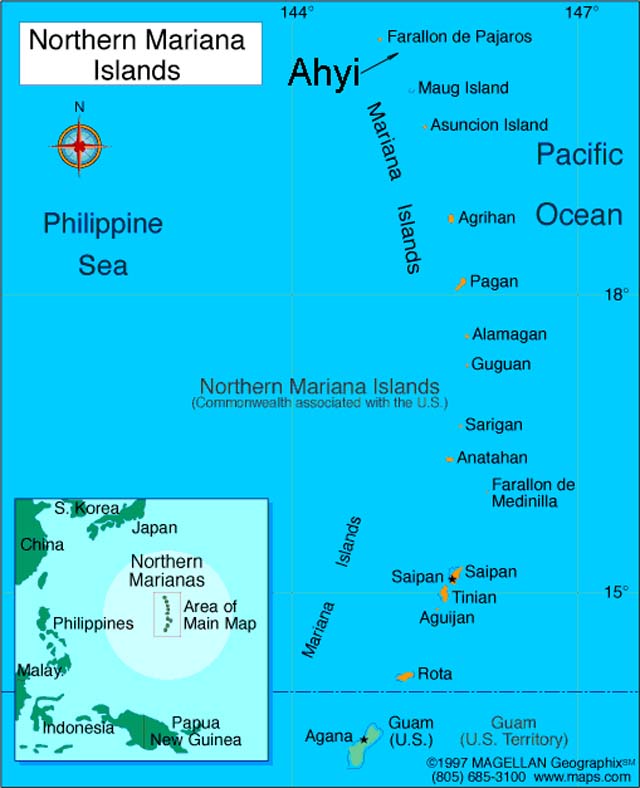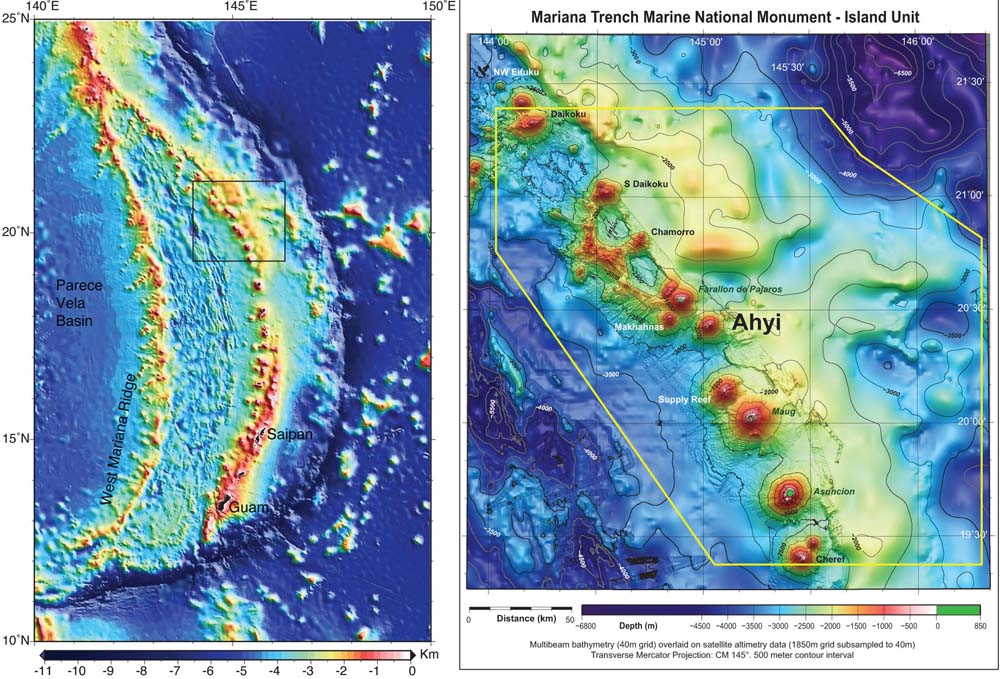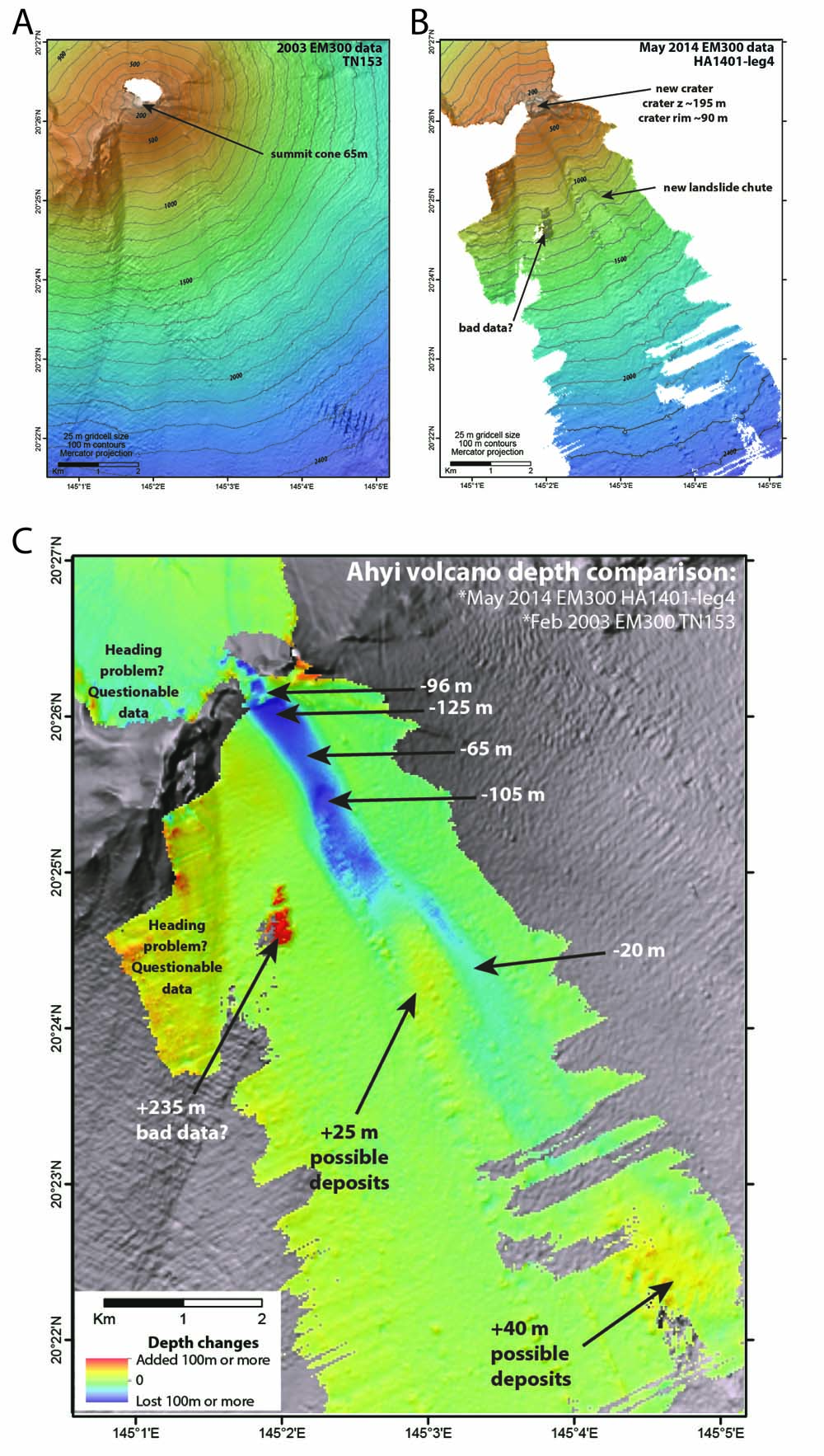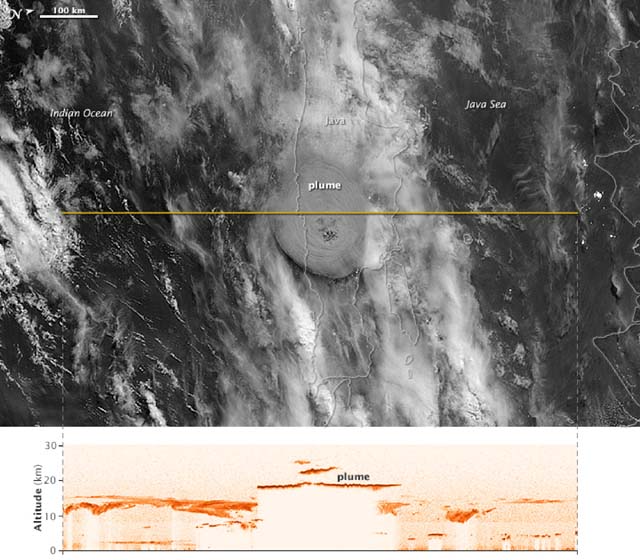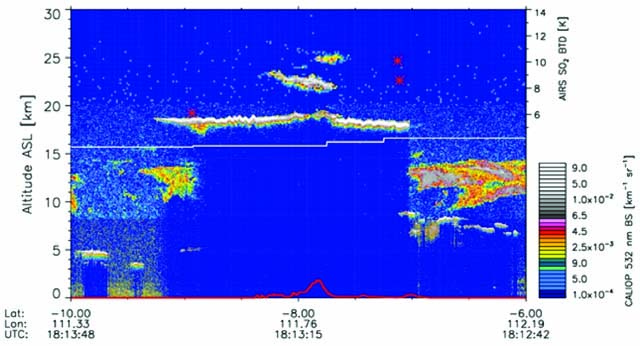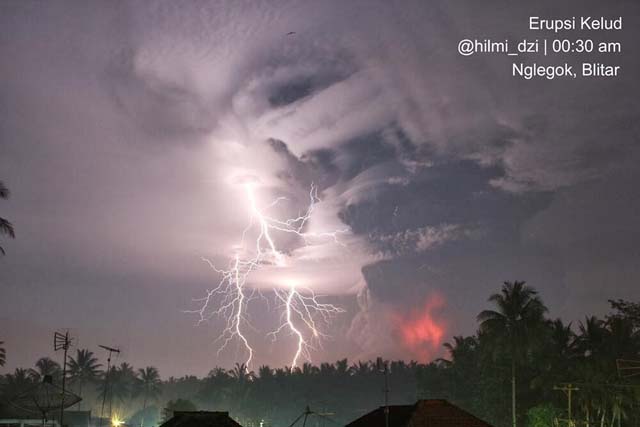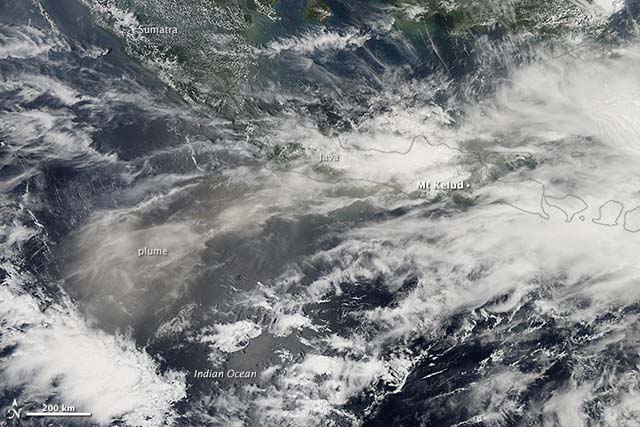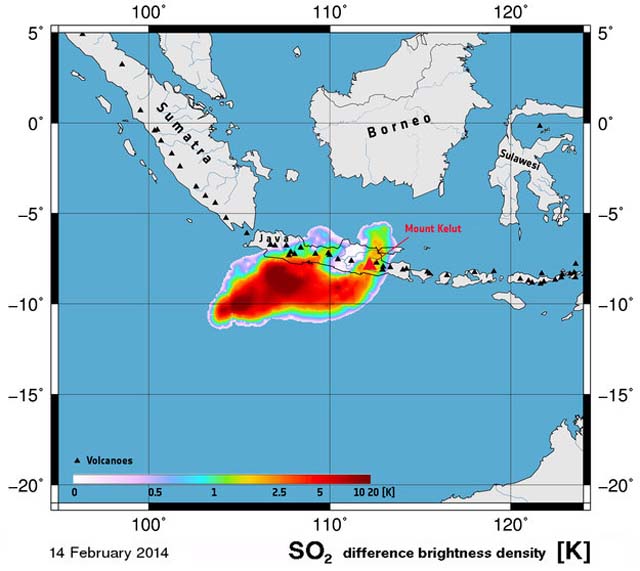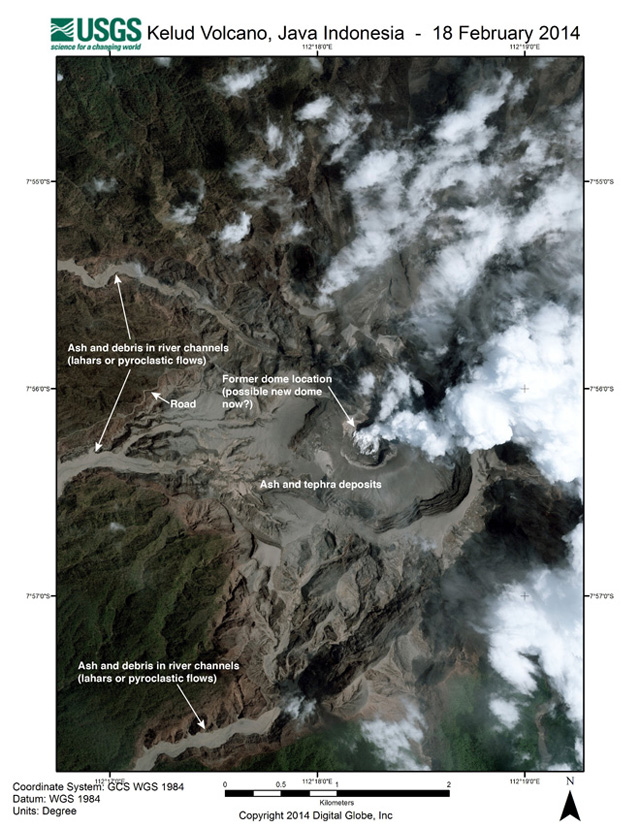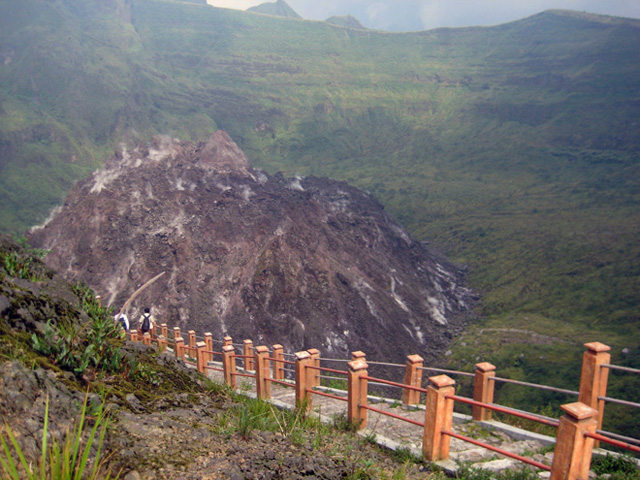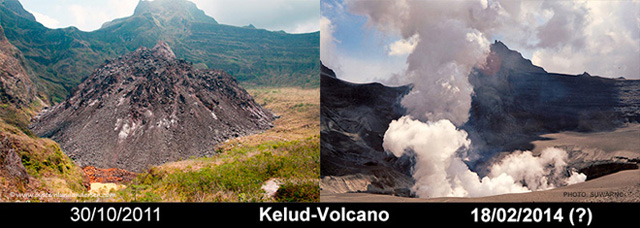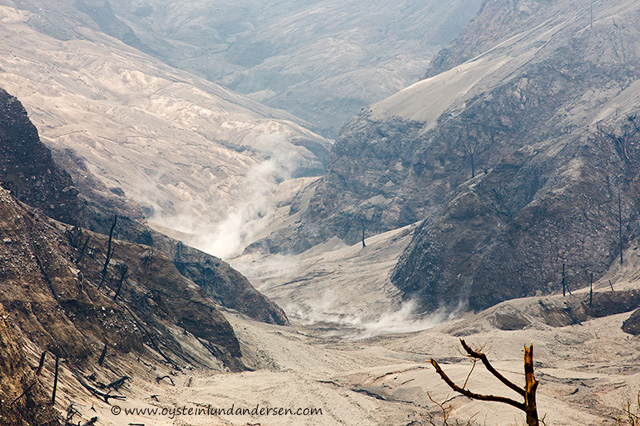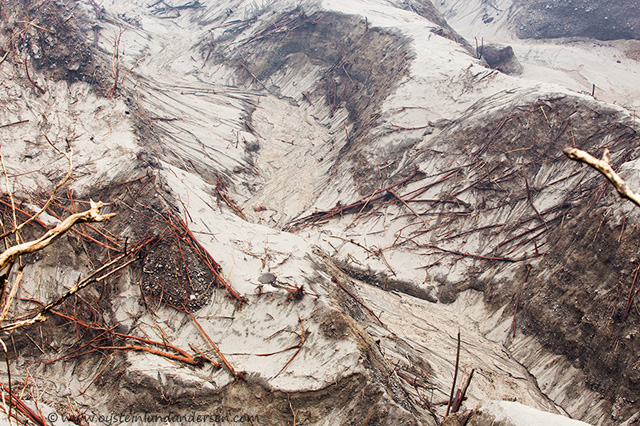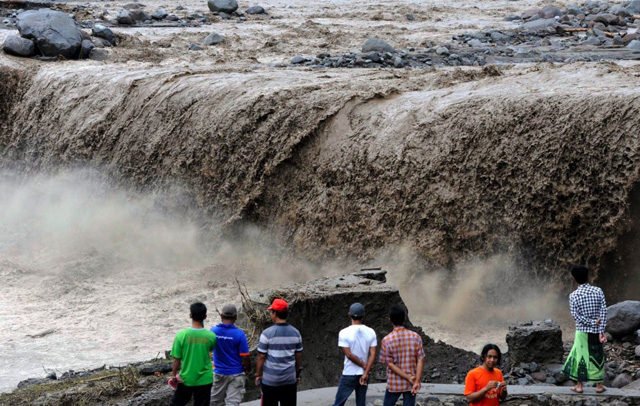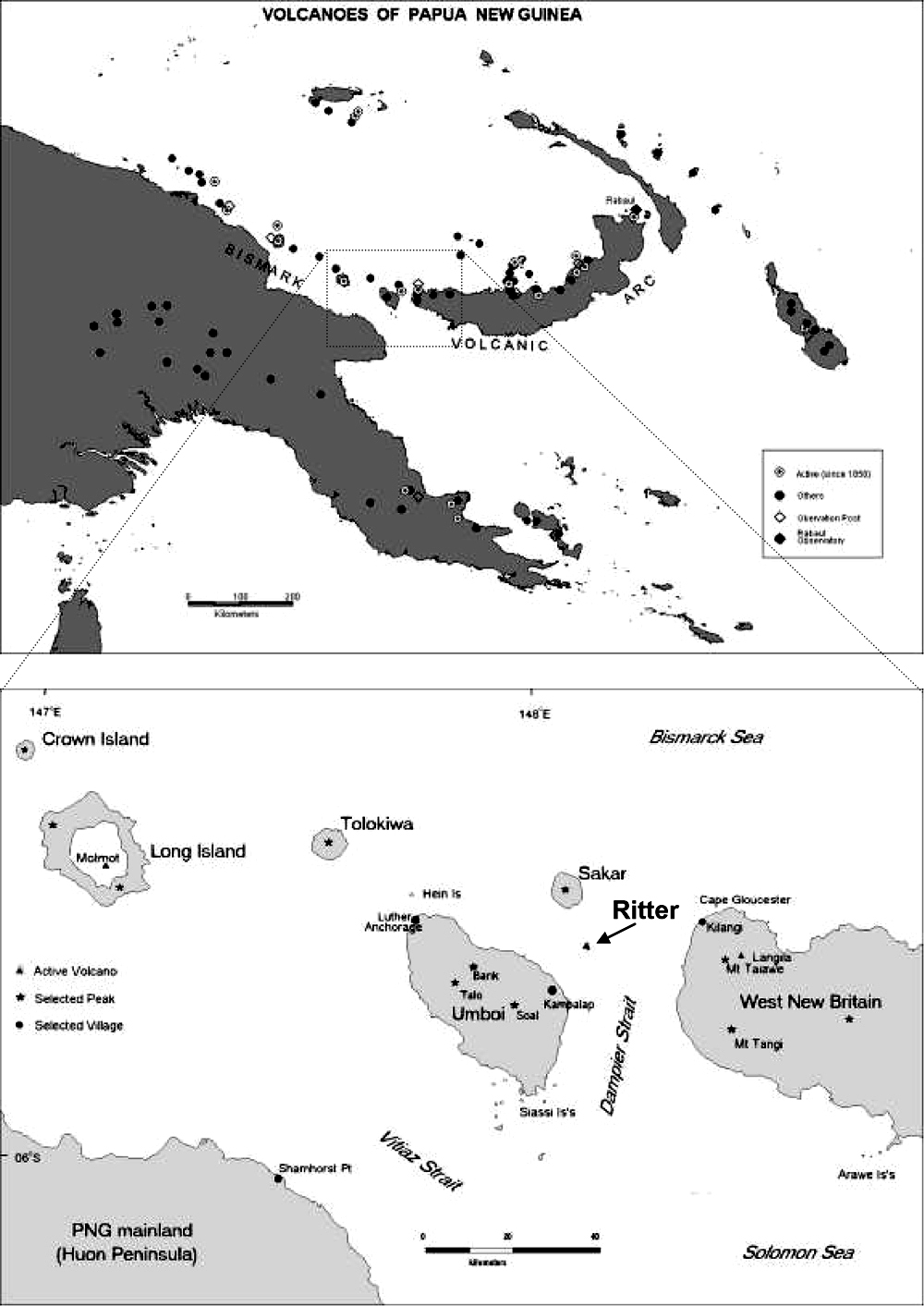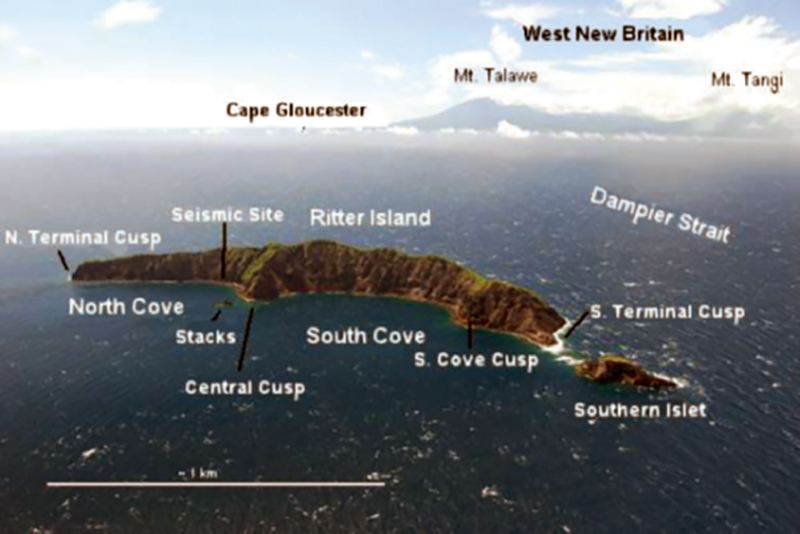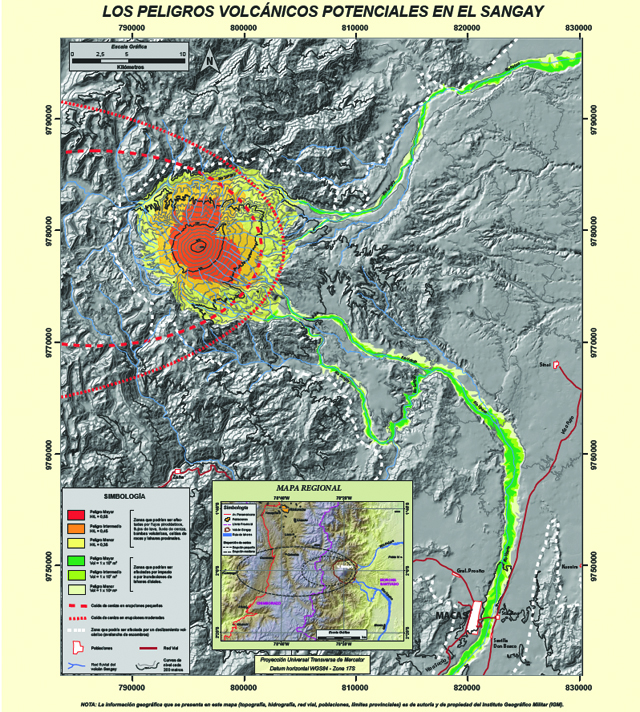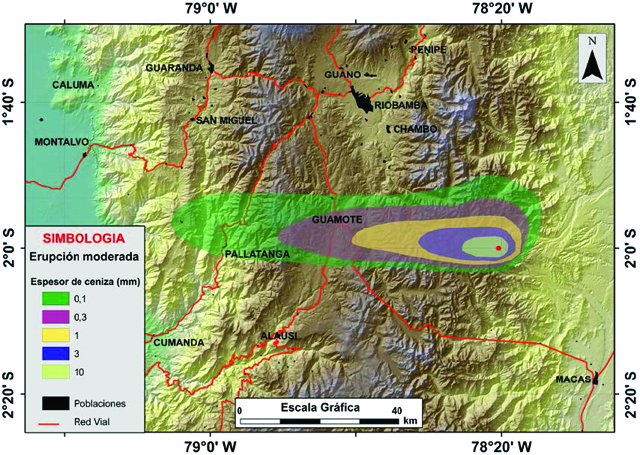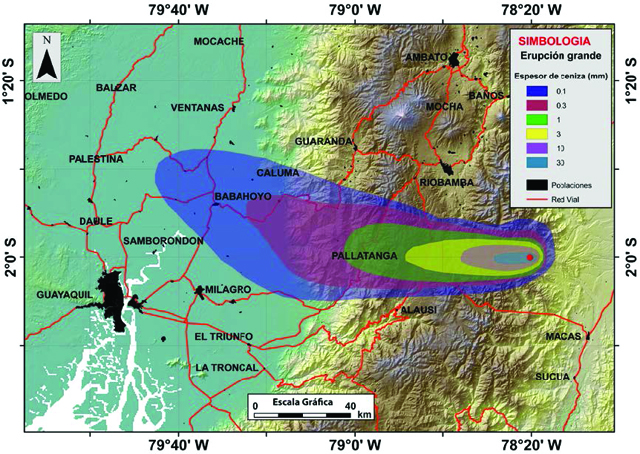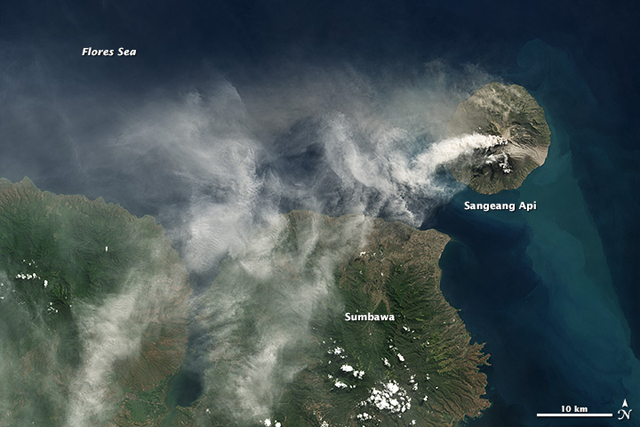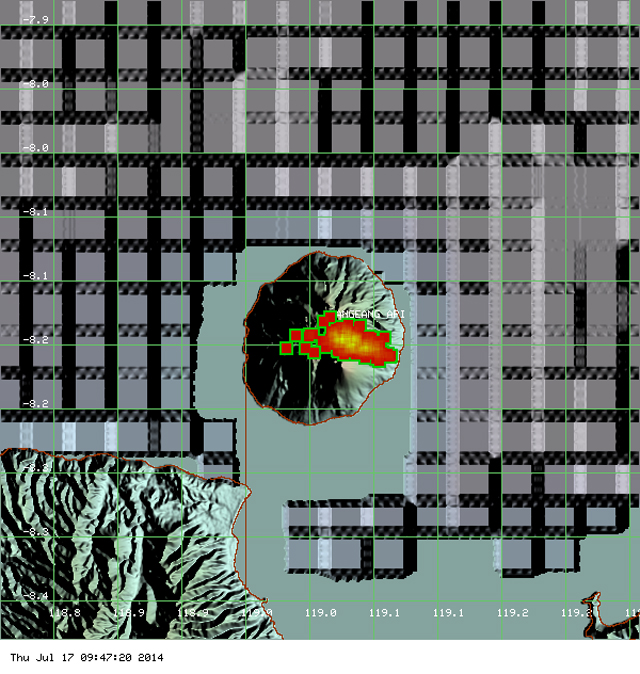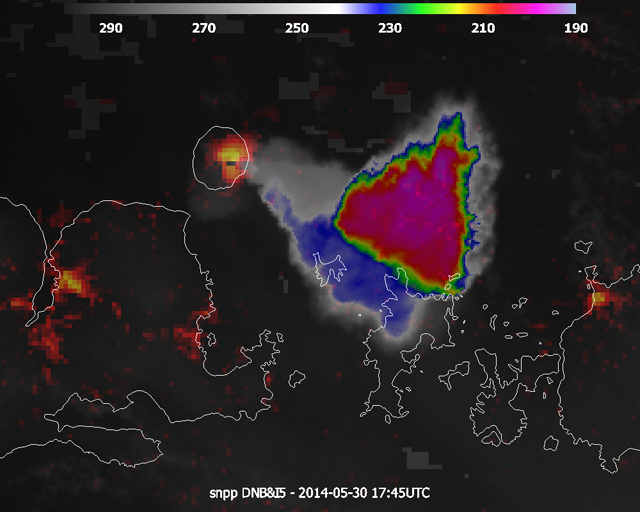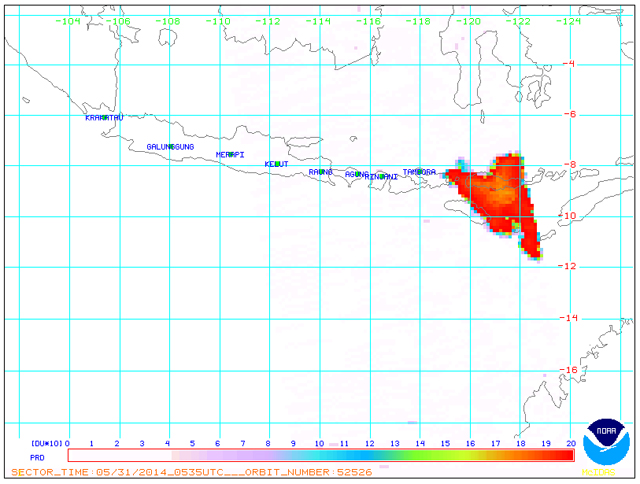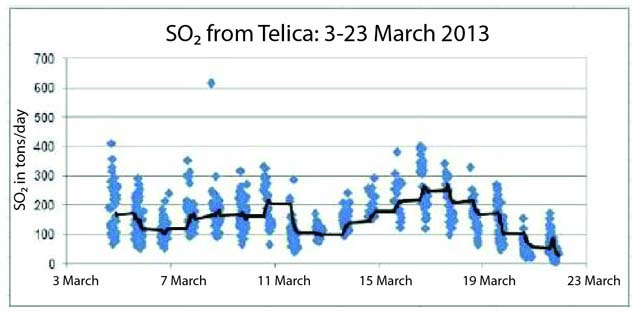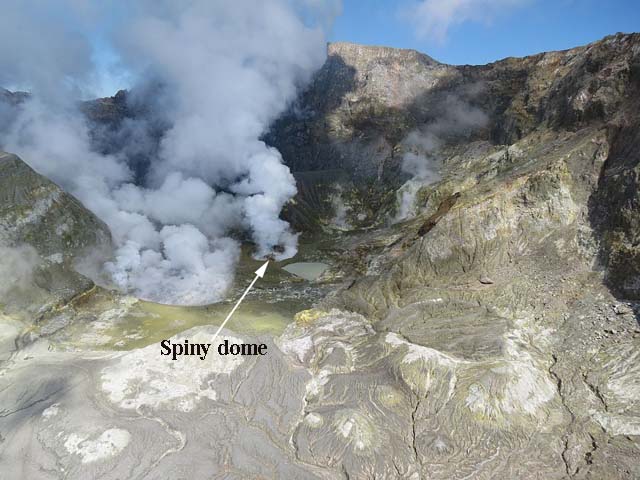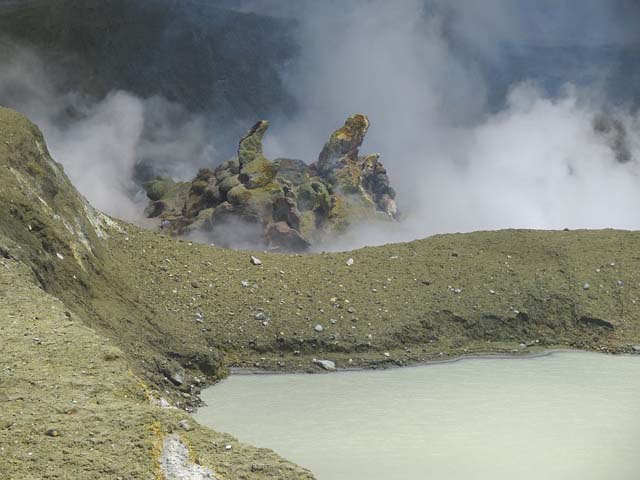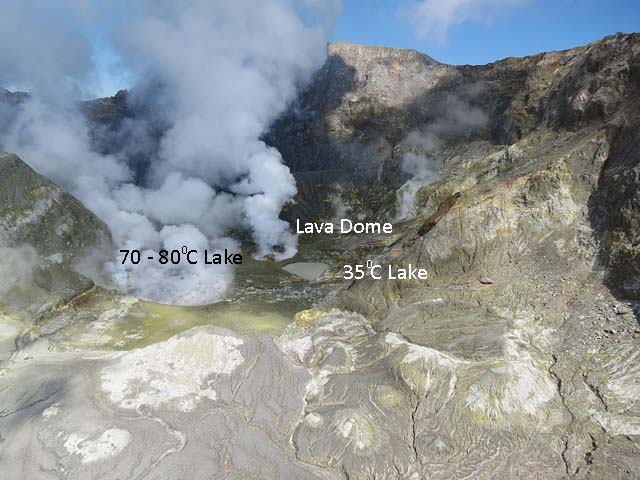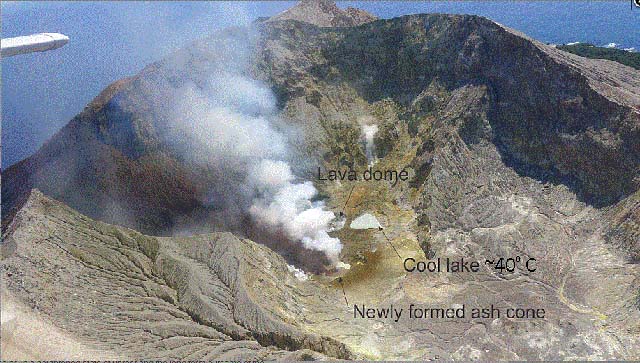Recently Published Bulletin Reports
Erebus (Antarctica) Lava lake remains active; most thermal alerts recorded since 2019
Rincon de la Vieja (Costa Rica) Frequent phreatic explosions during July-December 2023
Bezymianny (Russia) Explosion on 18 October 2023 sends ash plume 8 km high; lava flows and incandescent avalanches
Kilauea (United States) Low-level lava effusions in the lava lake at Halema’uma’u during July-December 2022
Nyamulagira (DR Congo) Lava flows and thermal activity during May-October 2023
Bagana (Papua New Guinea) Explosions, ash plumes, ashfall, and lava flows during April-September 2023
Mayon (Philippines) Lava flows, pyroclastic flows, ash emissions, and seismicity during April-September 2023
Nishinoshima (Japan) Eruption plumes and gas-and-steam plumes during May-August 2023
Krakatau (Indonesia) White gas-and-steam plumes and occasional ash plumes during May-August 2023
Villarrica (Chile) Strombolian activity, gas-and-ash emissions, and crater incandescence during April-September 2023
Merapi (Indonesia) Frequent incandescent avalanches during April-September 2023
Ebeko (Russia) Moderate explosive activity with ash plumes continued during June-November 2023
Erebus (Antarctica) — January 2024  Cite this Report
Cite this Report
Erebus
Antarctica
77.53°S, 167.17°E; summit elev. 3794 m
All times are local (unless otherwise noted)
Lava lake remains active; most thermal alerts recorded since 2019
The lava lake in the summit crater of Erebus has been active since at least 1972. Located in Antarctica overlooking the McMurdo Station on Ross Island, it is the southernmost active volcano on the planet. Because of the remote location, activity is primarily monitored by satellites. This report covers activity during 2023.
The number of thermal alerts recorded by the Hawai'i Institute of Geophysics and Planetology’s MODVOLC Thermal Alerts System increased considerably in 2023 compared to the years 2020-2022 (table 9). In contrast to previous years, the MODIS instruments aboard the Aqua and Terra satellites captured data from Erebus every month during 2023. Consistent with previous years, the lowest number of anomalous pixels were recorded in January, November, and December.
Table 9. Number of monthly MODIS-MODVOLC thermal alert pixels recorded at Erebus during 2017-2023. See BGVN 42:06 for data from 2000 through 2016. The table was compiled using data provided by the HIGP – MODVOLC Thermal Alerts System.
| Year |
Jan |
Feb |
Mar |
Apr |
May |
Jun |
Jul |
Aug |
Sep |
Oct |
Nov |
Dec |
SUM |
| 2017 |
0 |
21 |
9 |
0 |
0 |
1 |
11 |
61 |
76 |
52 |
0 |
3 |
234 |
| 2018 |
0 |
21 |
58 |
182 |
55 |
17 |
137 |
172 |
103 |
29 |
0 |
0 |
774 |
| 2019 |
2 |
21 |
162 |
151 |
55 |
56 |
75 |
53 |
29 |
19 |
1 |
0 |
624 |
| 2020 |
0 |
2 |
16 |
18 |
4 |
4 |
1 |
3 |
18 |
3 |
1 |
6 |
76 |
| 2021 |
0 |
9 |
1 |
0 |
2 |
56 |
46 |
47 |
35 |
52 |
5 |
3 |
256 |
| 2022 |
1 |
13 |
55 |
22 |
15 |
32 |
39 |
19 |
31 |
11 |
0 |
0 |
238 |
| 2023 |
2 |
33 |
49 |
82 |
41 |
32 |
70 |
64 |
42 |
17 |
5 |
11 |
448 |
Sentinel-2 infrared images showed one or two prominent heat sources within the summit crater, accompanied by adjacent smaller sources, similar to recent years (see BGVN 46:01, 47:02, and 48:01). A unique image was obtained on 25 November 2023 by the OLI-2 (Operational Land Imager-2) on Landsat 9, showing the upper part of the volcano surrounded by clouds (figure 32).
Geologic Background. Mount Erebus, the world's southernmost historically active volcano, overlooks the McMurdo research station on Ross Island. It is the largest of three major volcanoes forming the crudely triangular Ross Island. The summit of the dominantly phonolitic volcano has been modified by one or two generations of caldera formation. A summit plateau at about 3,200 m elevation marks the rim of the youngest caldera, which formed during the late-Pleistocene and within which the modern cone was constructed. An elliptical 500 x 600 m wide, 110-m-deep crater truncates the summit and contains an active lava lake within a 250-m-wide, 100-m-deep inner crater; other lava lakes are sometimes present. The glacier-covered volcano was erupting when first sighted by Captain James Ross in 1841. Continuous lava-lake activity with minor explosions, punctuated by occasional larger Strombolian explosions that eject bombs onto the crater rim, has been documented since 1972, but has probably been occurring for much of the volcano's recent history.
Information Contacts: Hawai'i Institute of Geophysics and Planetology (HIGP) - MODVOLC Thermal Alerts System, School of Ocean and Earth Science and Technology (SOEST), Univ. of Hawai'i, 2525 Correa Road, Honolulu, HI 96822, USA (URL: http://modis.higp.hawaii.edu/); Copernicus Browser, Copernicus Data Space Ecosystem, European Space Agency (URL: https://dataspace.copernicus.eu/browser/); NASA Earth Observatory, EOS Project Science Office, NASA Goddard Space Flight Center, Goddard, Maryland, USA (URL: https://earthobservatory.nasa.gov/images/152134/erebus-breaks-through).
Rincon de la Vieja (Costa Rica) — January 2024  Cite this Report
Cite this Report
Rincon de la Vieja
Costa Rica
10.83°N, 85.324°W; summit elev. 1916 m
All times are local (unless otherwise noted)
Frequent phreatic explosions during July-December 2023
Rincón de la Vieja is a volcanic complex in Costa Rica with a hot convecting acid lake that exhibits frequent weak phreatic explosions, gas-and-steam emissions, and occasional elevated sulfur dioxide levels (BGVN 45:10, 46:03, 46:11). The current eruption period began June 2021. This report covers activity during July-December 2023 and is based on weekly bulletins and occasional daily reports from the Observatorio Vulcanologico Sismologica de Costa Rica-Universidad Nacional (OVSICORI-UNA).
Numerous weak phreatic explosions continued during July-December 2023, along with gas-and-steam emissions and plumes that rose as high as 3 km above the crater rim. Many weekly OVSICORI-UNA bulletins included the previous week's number of explosions and emissions (table 9). For many explosions, the time of explosion was given (table 10). Frequent seismic activity (long-period earthquakes, volcano-tectonic earthquakes, and tremor) accompanied the phreatic activity.
Table 9. Number of reported weekly phreatic explosions and gas-and-steam emissions at Rincón de la Vieja, July-December 2023. Counts are reported for the week before the Weekly Bulletin date; not all reports included these data. Courtesy of OVSICORI-UNA.
| OVSICORI Weekly Bulletin |
Number of explosions |
Number of emissions |
| 28 Jul 2023 |
6 |
14 |
| 4 Aug 2023 |
10 |
12 |
| 1 Sep 2023 |
13 |
11 |
| 22 Sep 2023 |
12 |
13 |
| 29 Sep 2023 |
6 |
11 |
| 6 Oct 2023 |
12 |
5 |
| 13 Oct 2023 |
7 |
9 |
| 20 Oct 2023 |
1 |
15 |
| 27 Oct 2023 |
3 |
23 |
| 3 Nov 2023 |
3 |
10 |
| 17 Nov 2023 |
0 |
Some |
| 24 Nov 2023 |
0 |
14 |
| 8 Dec 2023 |
4 |
16 |
| 22 Dec 2023 |
8 |
18 |
Table 10. Summary of activity at Rincón de la Vieja during July-December 2023. Weak phreatic explosions and gas emissions are noted where the time of explosion was indicated in the weekly or daily bulletins. Height of plumes or emissions are distance above the crater rim. Courtesy of OVSICORI-UNA.
| Date |
Time |
Description of Activity |
| 1 Jul 2023 |
0156 |
Explosion. |
| 2 Jul 2023 |
0305 |
Explosion. |
| 4 Jul 2023 |
0229, 0635 |
Event at 0635 produced a gas-and-steam plume that rose 700 m and drifted W; seen by residents in Liberia (21 km SW). |
| 9 Jul 2023 |
1843 |
Explosion. |
| 21 Jul 2023 |
0705 |
Explosion. |
| 26 Jul 2023 |
1807 |
Explosion. |
| 28 Jul 2023 |
0802 |
Explosion generated a gas-and-steam plume that rose 500 m. |
| 30 Jul 2023 |
1250 |
Explosion. |
| 31 Jul 2023 |
2136 |
Explosion. |
| 11 Aug 2023 |
0828 |
Explosion. |
| 18 Aug 2023 |
1304 |
Explosion. |
| 21 Aug 2023 |
1224 |
Explosion generated gas-and-steam plumes rose 500-600 m. |
| 22 Aug 2023 |
0749 |
Explosion generated gas-and-steam plumes rose 500-600 m. |
| 24 Aug 2023 |
1900 |
Explosion. |
| 25 Aug 2023 |
0828 |
Event produced a steam-and-gas plume that rose 3 km and drifted NW. |
| 27-28 Aug 2023 |
0813 |
Four small events; the event at 0813 on 28 August lasted two minutes and generated a steam-and-gas plume that rose 2.5 km. |
| 1 Sep 2023 |
1526 |
Explosion generated plume that rose 2 km and ejected material onto the flanks. |
| 2-3 Sep 2023 |
- |
Small explosions detected in infrasound data. |
| 4 Sep 2023 |
1251 |
Gas-and-steam plume rose 1 km and drifted W. |
| 7 Nov 2023 |
1113 |
Explosion. |
| 8 Nov 2023 |
0722 |
Explosion. |
| 12 Nov 2023 |
0136 |
Small gas emissions. |
| 14 Nov 2023 |
0415 |
Small gas emissions. |
According to OVSICORI-UNA, during July-October the average weekly sulfur dioxide (SO2) flux ranged from 68 to 240 tonnes/day. However, in mid-November the flux increased to as high as 334 tonnes/day, the highest value measured in recent years. The high SO2 flux in mid-November was also detected by the TROPOMI instrument on the Sentinel-5P satellite (figure 43).
Geologic Background. Rincón de la Vieja, the largest volcano in NW Costa Rica, is a remote volcanic complex in the Guanacaste Range. The volcano consists of an elongated, arcuate NW-SE-trending ridge constructed within the 15-km-wide early Pleistocene Guachipelín caldera, whose rim is exposed on the south side. Sometimes known as the "Colossus of Guanacaste," it has an estimated volume of 130 km3 and contains at least nine major eruptive centers. Activity has migrated to the SE, where the youngest-looking craters are located. The twin cone of Santa María volcano, the highest peak of the complex, is located at the eastern end of a smaller, 5-km-wide caldera and has a 500-m-wide crater. A Plinian eruption producing the 0.25 km3 Río Blanca tephra about 3,500 years ago was the last major magmatic eruption. All subsequent eruptions, including numerous historical eruptions possibly dating back to the 16th century, have been from the prominent active crater containing a 500-m-wide acid lake located ENE of Von Seebach crater.
Information Contacts: Observatorio Vulcanológico Sismológica de Costa Rica-Universidad Nacional (OVSICORI-UNA), Apartado 86-3000, Heredia, Costa Rica (URL: http://www.ovsicori.una.ac.cr/); NASA Global Sulfur Dioxide Monitoring Page, Atmospheric Chemistry and Dynamics Laboratory, NASA Goddard Space Flight Center (NASA/GSFC), 8800 Greenbelt Road, Goddard MD 20771, USA (URL: https://so2.gsfc.nasa.gov/).
Bezymianny (Russia) — November 2023  Cite this Report
Cite this Report
Bezymianny
Russia
55.972°N, 160.595°E; summit elev. 2882 m
All times are local (unless otherwise noted)
Explosion on 18 October 2023 sends ash plume 8 km high; lava flows and incandescent avalanches
Bezymianny, located on Russia’s Kamchatka Peninsula, has had eruptions since 1955 characterized by dome growth, explosions, pyroclastic flows, ash plumes, and ashfall. Activity during November 2022-April 2023 included gas-and-steam emissions, lava dome collapses generating avalanches, and persistent thermal activity. Similar eruptive activity continued from May through October 2023, described here based on information from weekly and daily reports of the Kamchatka Volcano Eruptions Response Team (KVERT), notices from Tokyo VAAC (Volcanic Ash Advisory Center), and from satellite data.
Overall activity decreased after the strong period of activity in late March through April 2023, which included ash explosions during 29 March and 7-8 April 2023 that sent plumes as high as 10-12 km altitude, along with dome growth and lava flows (BGVN 48:05). This reduced activity can be seen in the MIROVA thermal detection system graph (figure 56), which was consistent with data from the MODVOLC thermal detection system and with Sentinel-2 satellite images that showed persistent hotspots in the summit crater when conditions allowed observations. A renewed period of strong activity began in mid-October 2023.
Activity increased significantly on 17 October 2023 when large collapses began during 0700-0830 on the E flanks of the lava dome and continued to after 0930 the next day (figure 57). Ash plumes rose to an altitude of 4.5-5 km, extending 220 km NNE by 18 October. A large explosion at 1630 on 18 October produced an ash plume that rose to an altitude of 11 km (8 km above the summit) and drifted NNE and then NW, extending 900 km NW within two days at an altitude of 8 km. Minor ashfall was noted in Kozyrevsk (45 km WNW). At 0820 on 20 October an ash plume was identified in satellite images drifting 100 km ENE at altitudes of 4-4.5 km.
Lava flows and hot avalanches from the dome down the SE flank continued over the next few days, including 23 October when clear conditions allowed good observations (figures 58 and 59). A large thermal anomaly was observed over the volcano through 24 October, and in the summit crater on 30 October (figure 60). Strong fumarolic activity continued, with numerous avalanches and occasional incandescence. By the last week of October, volcanic activity had decreased to a level consistent with that earlier in the reporting period.
Aviation warnings were frequently updated during 17-20 October. KVERT issued a Volcano Observatory Notice for Aviation (VONA) on 17 October at 1419 and 1727 (0219 and 0527 UTC) raising the Aviation Color Code (ACC) from Yellow to Orange (second highest level). The next day, KVERT issued a VONA at 1705 (0505 UTC) raising the ACC to Red (highest level) but lowered it back to Orange at 2117 (0917 UTC). After another decrease to Yellow and back to Orange, the ACC was reduced to Yellow on 20 October at 1204 (0004 UTC). In addition, the Tokyo VAAC issued a series of Volcanic Ash Advisories beginning on 16 October and continuing through 30 October.
Geologic Background. The modern Bezymianny, much smaller than its massive neighbors Kamen and Kliuchevskoi on the Kamchatka Peninsula, was formed about 4,700 years ago over a late-Pleistocene lava-dome complex and an edifice built about 11,000-7,000 years ago. Three periods of intensified activity have occurred during the past 3,000 years. The latest period, which was preceded by a 1,000-year quiescence, began with the dramatic 1955-56 eruption. This eruption, similar to that of St. Helens in 1980, produced a large open crater that was formed by collapse of the summit and an associated lateral blast. Subsequent episodic but ongoing lava-dome growth, accompanied by intermittent explosive activity and pyroclastic flows, has largely filled the 1956 crater.
Information Contacts: Kamchatka Volcanic Eruptions Response Team (KVERT), Far Eastern Branch, Russian Academy of Sciences, 9 Piip Blvd., Petropavlovsk-Kamchatsky, 683006, Russia (URL: http://www.kscnet.ru/ivs/kvert/); Kamchatka Volcanological Station, Kamchatka Branch of Geophysical Survey, (KB GS RAS), Klyuchi, Kamchatka Krai, Russia (URL: http://volkstat.ru/); Tokyo Volcanic Ash Advisory Center (VAAC), 1-3-4 Otemachi, Chiyoda-ku, Tokyo 100-8122, Japan (URL: http://ds.data.jma.go.jp/svd/vaac/data/); Hawai'i Institute of Geophysics and Planetology (HIGP) - MODVOLC Thermal Alerts System, School of Ocean and Earth Science and Technology (SOEST), Univ. of Hawai'i, 2525 Correa Road, Honolulu, HI 96822, USA (URL: http://modis.higp.hawaii.edu/); MIROVA (Middle InfraRed Observation of Volcanic Activity), a collaborative project between the Universities of Turin and Florence (Italy) supported by the Centre for Volcanic Risk of the Italian Civil Protection Department (URL: http://www.mirovaweb.it/); Copernicus Browser, Copernicus Data Space Ecosystem, European Space Agency (URL: https://dataspace.copernicus.eu/browser/).chr
Kilauea (United States) — January 2023  Cite this Report
Cite this Report
Kilauea
United States
19.421°N, 155.287°W; summit elev. 1222 m
All times are local (unless otherwise noted)
Low-level lava effusions in the lava lake at Halema’uma’u during July-December 2022
Kīlauea is the southeastern-most volcano in Hawaii and overlaps the E flank of the Mauna Loa volcano. Its East Rift Zone (ERZ) has been intermittently active for at least 2,000 years. An extended eruption period began in January 1983 and was characterized by open lava lakes and lava flows from the summit caldera and the East Rift Zone. During May 2018 magma migrated into the Lower East Rift Zone (LERZ) and opened 24 fissures along a 6-km-long NE-trending fracture zone that produced lava flows traveling in multiple directions. As lava emerged from the fissures, the lava lake at Halema'uma'u drained and explosions sent ash plumes to several kilometers altitude (BGVN 43:10).
The current eruption period started during September 2021 and has recently been characterized by lava effusions, spatter, and sulfur dioxide emissions in the active Halema’uma’u lava lake (BGVN 47:08). Lava effusions, some spatter, and sulfur dioxide emissions have continued during this reporting period of July through December 2022 using daily reports, volcanic activity notices, and abundant photo, map, and video data from the US Geological Survey's (USGS) Hawaiian Volcano Observatory (HVO).
Summary of activity during July-December 2022. Low-level effusions have continued at the western vent of the Halema’uma’u crater during July through early December 2022. Occasional weak ooze-outs (also called lava break outs) would occur along the margins of the crater floor. The overall level of the active lava lake throughout the reporting period gradually increased due to infilling, however it stagnated in mid-September (table 13). During September through November, activity began to decline, though lava effusions persisted at the western vent. By 9 December, the active part of the lava lake had completely crusted over, and incandescence was no longer visible.
Table 13. Summary of measurements taken during overflights at Kīlauea that show a gradual increase in the active lava lake level and the volume of lava effused since 29 September 2021. Lower activity was reported during September-October. Data collected during July-December 2022. Courtesy of HVO.
| Date: |
Level of the active lava lake (m): |
Cumulative volume of lava effused (million cubic meters): |
| 7 Jul 2022 |
130 |
95 |
| 19 Jul 2022 |
133 |
98 |
| 4 Aug 2022 |
136 |
102 |
| 16 Aug 2022 |
137 |
104 |
| 12 Sep 2022 |
143 |
111 |
| 5 Oct 2022 |
143 |
111 |
| 28 Oct 2022 |
143 |
111 |
Activity during July 2022. Lava effusions were reported from the western vent in the Halema’uma’u crater, along with occasional weak ooze-outs along the margins of the crater floor. The height of the lava lake was variable due to deflation-inflation tilt events; for example, the lake level dropped approximately 3-4 m during a summit deflation-inflation event reported on 1 July. Webcam images taken during the night of 6-12 July showed intermittent low-level spattering at the western vent that rose less than 10 m above the vent (figure 519). Measurements made during an overflight on 7 July indicated that the crater floor was infilled about 130 m and that 95 million cubic meters of lava had been effused since 29 September 2021. A single, relatively small lava ooze-out was active to the S of the lava lake. Around midnight on 8 July there were two brief periods of lava overflow onto the lake margins. On 9 July lava ooze-outs were reported near the SE and NE edges of the crater floor and during 10-11 July they occurred near the E, NE, and NW edges. On 16 July crater incandescence was reported, though the ooze-outs and spattering were not visible. On 18 July overnight webcam images showed incandescence in the western vent complex and two ooze-outs were reported around 0000 and 0200 on 19 July. By 0900 there were active ooze-outs along the SW edge of the crater floor. Measurements made from an overflight on 19 July indicated that the crater floor was infilled about 133 m and 98 million cubic meters of lava had erupted since 29 September 2021 (figure 520). On 20 July around 1600 active ooze-outs were visible along the N edge of the crater, which continued through the next day. Extensive ooze-outs occurred along the W margin during 24 July until 1900; on 26 July minor ooze-outs were noted along the N margin. Minor spattering was visible on 29 July along the E margin of the lake. The sulfur dioxide emission rates ranged 650-2,800 tons per day (t/d), the higher of which was measured on 8 July (figure 519).
Activity during August 2022. The eruption continued in the Halema’uma’u crater at the western vent. According to HVO the lava in the active lake remained at the level of the bounding levees. Occasional minor ooze-outs were observed along the margins of the crater floor. Strong nighttime crater incandescence was visible after midnight on 6 August over the western vent cone. During 6-7 August scattered small lava lobes were active along the crater floor and incandescence persisted above the western vent through 9 August. During 7-9 August HVO reported a single lava effusion source was active along the NW margin of the crater floor. Measurements from an overflight on 4 August indicated that the crater floor was infilled about 136 m total and that 102 million cubic meters of lava had been erupted since the start of the eruption. Lava breakouts were reported along the N, NE, E, S, and W margins of the crater during 10-16 August. Another overflight survey conducted on 16 August indicated that the crater floor infilled about 137 m and 104 million cubic meters of lava had been erupted since September 2021. Measured sulfur dioxide emissions rates ranged 1,150-2,450 t/d, the higher of which occurred on 8 August.
Activity during September 2022. During September, lava effusion continued from the western vent into the active lava lake and onto the crater floor. Intermittent minor ooze-outs were reported through the month. A small ooze-out was visible on the W crater floor margin at 0220 on 2 September, which showed decreasing surface activity throughout the day, but remained active through 3 September. On 3 September around 1900 a lava outbreak occurred along the NW margin of the crater floor but had stopped by the evening of 4 September. Field crews monitoring the summit lava lake on 9 September observed spattering on the NE margin of the lake that rose no higher than 10 m, before falling back onto the lava lake crust (figure 521). Overflight measurements on 12 September indicated that the crater floor was infilled a total of 143 m and 111 million cubic meters of lava had been erupted since September 2021. Extensive breakouts in the W and N part of the crater floor were reported at 1600 on 20 September and continued into 26 September. The active part of the lava lake dropped by 10 m while other parts of the crater floor dropped by several meters. Summit tiltmeters recorded a summit seismic swarm of more than 80 earthquakes during 1500-1800 on 21 September, which occurred about 1.5 km below Halema’uma’u; a majority of these were less than Mw 2. By 22 September the active part of the lava lake was infilled about 2 m. On 23 September the western vent areas exhibited several small spatter cones with incandescent openings, along with weak, sporadic spattering (figure 522). The sulfur dioxide emission rate ranged from 930 t/d to 2,000 t/d, the higher of which was measured on 6 September.
Activity during October 2022. Activity during October declined slightly compared to previous months, though lava effusions persisted from the western vent into the active lava lake and onto the crater floor during October (figure 523). Slight variations in the lava lake were noted throughout the month. HVO reported that around 0600 on 3 October the level of the lava lake has lowered slightly. Overflight measurements taken on 5 October indicated that the crater floor was infilled a total of about 143 m and that 111 million cubic meters of lava had been effused since September 2021. During 6-7 October the lake gradually rose 0.5 m. Sulfur dioxide measurements made on 22 October had an emission rate of 700 t/d. Another overflight taken on 28 October showed that there was little to no change in the elevation of the crater floor: the crater floor was infilled a total of 143 m and 111 million cubic meters of lava had erupted since the start of the eruption.
Activity during November 2022. Activity remained low during November, though HVO reported that lava from the western vent continued to effuse into the active lava lake and onto the crater floor throughout the month. The rate of sulfur dioxide emissions during November ranged from 300-600 t/d, the higher amount of which occurred on 9 November.
Activity during December 2022. Similar low activity was reported during December, with lava effusing from the western vent into the active lava lake and onto the crater floor. During 4-5 December the active part of the lava lake was slightly variable in elevation and fluctuated within 1 m. On 9 December HVO reported that lava was no longer erupting from the western vent in the Halema’uma’u crater and that sulfur dioxide emissions had returned to near pre-eruption background levels; during 10-11 December, the lava lake had completely crusted over, and no incandescence was visible (figure 524). Time lapse camera images covering the 4-10 December showed that the crater floor showed weak deflation and no inflation. Some passive events of crustal overturning were reported during 14-15 December, which brought fresh incandescent lava to the lake surface. The sulfur dioxide emission rate was approximately 200 t/d on 14 December. A smaller overturn event on 17 December and another that occurred around 0000 and into the morning of 20 December were also detected. A small seismic swarm was later detected on 30 December.
Geologic Background. Kilauea overlaps the E flank of the massive Mauna Loa shield volcano in the island of Hawaii. Eruptions are prominent in Polynesian legends; written documentation since 1820 records frequent summit and flank lava flow eruptions interspersed with periods of long-term lava lake activity at Halemaumau crater in the summit caldera until 1924. The 3 x 5 km caldera was formed in several stages about 1,500 years ago and during the 18th century; eruptions have also originated from the lengthy East and Southwest rift zones, which extend to the ocean in both directions. About 90% of the surface of the basaltic shield volcano is formed of lava flows less than about 1,100 years old; 70% of the surface is younger than 600 years. The long-term eruption from the East rift zone between 1983 and 2018 produced lava flows covering more than 100 km2, destroyed hundreds of houses, and added new coastline.
Information Contacts: Hawaiian Volcano Observatory (HVO), U.S. Geological Survey, PO Box 51, Hawai'i National Park, HI 96718, USA (URL: http://hvo.wr.usgs.gov/).
Nyamulagira (DR Congo) — November 2023  Cite this Report
Cite this Report
Nyamulagira
DR Congo
1.408°S, 29.2°E; summit elev. 3058 m
All times are local (unless otherwise noted)
Lava flows and thermal activity during May-October 2023
Nyamulagira (also known as Nyamuragira) is a shield volcano in the Democratic Republic of Congo with the summit truncated by a small 2 x 2.3 km caldera with walls up to about 100 m high. Documented eruptions have occurred within the summit caldera, as well as from numerous flank fissures and cinder cones. The current eruption period began in April 2018 and has more recently been characterized by summit crater lava flows and thermal activity (BGVN 48:05). This report describes lava flows and variable thermal activity during May through October 2023, based on information from the Observatoire Volcanologique de Goma (OVG) and various satellite data.
Lava lake activity continued during May. The MIROVA (Middle InfraRed Observation of Volcanic Activity) system recorded moderate-to-strong thermal activity throughout the reporting period; activity was more intense during May and October and relatively weaker from June through September (figure 95). The MODVOLC thermal algorithm, detected a total of 209 thermal alerts. There were 143 hotspots detected during May, eight during June, nine during September, and 49 during October. This activity was also reflected in infrared satellite images, where a lava flow was visible in the NW part of the crater on 7 May and strong activity was seen in the center of the crater on 4 October (figure 96). Another infrared satellite image taken on 12 May showed still active lava flows along the NW margin of the crater. According to OVG lava effusions were active during 7-29 May and moved to the N and NW parts of the crater beginning on 9 May. Strong summit crater incandescence was visible from Goma (27 km S) during the nights of 17, 19, and 20 May (figure 97). On 17 May there was an increase in eruptive activity, which peaked at 0100 on 20 May. Notable sulfur dioxide plumes drifted NW and W during 19-20 May (figure 98). Drone footage acquired in partnership with the USGS (United States Geological Survey) on 20 May captured images of narrow lava flows that traveled about 100 m down the W flank (figure 99). Data from the Rumangabo seismic station indicated a decreasing trend in activity during 17-21 May. Although weather clouds prevented clear views of the summit, a strong thermal signature on the NW flank was visible in an infrared satellite image on 22 May, based on an infrared satellite image. On 28 May the lava flows on the upper W flank began to cool and solidify. By 29 May seismicity returned to levels similar to those recorded before the 17 May increase. Lava effusion continued but was confined to the summit crater; periodic crater incandescence was observed.
Low-level activity was noted during June through October. On 1 June OVG reported that seismicity remained at lower levels and that crater incandescence had been absent for three days, though infrared satellite imagery showed continued lava effusion in the summit crater. The lava flows on the flanks covered an estimated 0.6 km2. Satellite imagery continued to show thermal activity confined to the lava lake through October (figure 96), although no lava flows or significant sulfur dioxide emissions were reported.
Geologic Background. Africa's most active volcano, Nyamulagira (also known as Nyamuragira), is a massive high-potassium basaltic shield about 25 km N of Lake Kivu and 13 km NNW of the steep-sided Nyiragongo volcano. The summit is truncated by a small 2 x 2.3 km caldera that has walls up to about 100 m high. Documented eruptions have occurred within the summit caldera, as well as from the numerous flank fissures and cinder cones. A lava lake in the summit crater, active since at least 1921, drained in 1938, at the time of a major flank eruption. Recent lava flows extend down the flanks more than 30 km from the summit as far as Lake Kivu; extensive lava flows from this volcano have covered 1,500 km2 of the western branch of the East African Rift.
Information Contacts: Observatoire Volcanologique de Goma (OVG), Departement de Geophysique, Centre de Recherche en Sciences Naturelles, Lwiro, D.S. Bukavu, DR Congo; Hawai'i Institute of Geophysics and Planetology (HIGP) - MODVOLC Thermal Alerts System, School of Ocean and Earth Science and Technology (SOEST), Univ. of Hawai'i, 2525 Correa Road, Honolulu, HI 96822, USA (URL: http://modis.higp.hawaii.edu/); MIROVA (Middle InfraRed Observation of Volcanic Activity), a collaborative project between the Universities of Turin and Florence (Italy) supported by the Centre for Volcanic Risk of the Italian Civil Protection Department (URL: http://www.mirovaweb.it/); NASA Global Sulfur Dioxide Monitoring Page, Atmospheric Chemistry and Dynamics Laboratory, NASA Goddard Space Flight Center (NASA/GSFC), 8800 Greenbelt Road, Goddard, Maryland, USA (URL: https://so2.gsfc.nasa.gov/); Copernicus Browser, Copernicus Data Space Ecosystem, European Space Agency (URL: https://dataspace.copernicus.eu/browser/); Charles Balagizi, Goma Volcano Observatory, Departement de Geophysique, Centre de Recherche en Sciences Naturelles, Lwiro, D.S. Bukavu, DR Congo.
Bagana (Papua New Guinea) — October 2023  Cite this Report
Cite this Report
Bagana
Papua New Guinea
6.137°S, 155.196°E; summit elev. 1855 m
All times are local (unless otherwise noted)
Explosions, ash plumes, ashfall, and lava flows during April-September 2023
The remote volcano of Bagana is located in central Bougainville Island, Papua New Guinea. Recorded eruptions date back to 1842 and activity has consisted of effusive activity that has built a small lava dome in the summit crater and occasional explosions that produced pyroclastic flows. The most recent eruption has been ongoing since February 2000 and has produced occasional explosions, ash plumes, and lava flows. More recently, activity has been characterized by ongoing effusive activity and ash emissions (BGVN 48:04). This report updates activity from April through September 2023 that has consisted of explosions, ash plumes, ashfall, and lava flows, using information from the Darwin Volcanic Ash Advisory Center (VAAC) and satellite data.
An explosive eruption was reported on 7 July that generated a large gas-and-ash plume to high altitudes and caused significant ashfall in local communities; the eruption plume had reached upper tropospheric (16-18 km altitude) altitudes by 2200, according to satellite images. Sulfur dioxide plumes were detected in satellite images on 8 July and indicated that the plume was likely a mixture of gas, ice, and ash. A report issued by the Autonomous Bougainville Government (ABG) (Torokina District, Education Section) on 10 July noted that significant ash began falling during 2000-2100 on 7 July and covered most areas in the Vuakovi, Gotana (9 km SW), Koromaketo, Laruma (25 km W) and Atsilima (27 km NW) villages. Pyroclastic flows also occurred, according to ground-based reports; small deposits confined to one drainage were inspected by RVO during an overflight on 17 July and were confirmed to be from the 7 July event. Ashfall continued until 10 July and covered vegetation, which destroyed bushes and gardens and contaminated rivers and streams.
RVO reported another eruption on 14 July. The Darwin VAAC stated that an explosive event started around 0830 on 15 July and produced an ash plume that rose to 16.5 km altitude by 1000 and drifted N, according to satellite images. The plume continued to drift N and remained visible through 1900, and by 2150 it had dissipated.
Ashfall likely from both the 7 and 15 July events impacted about 8,111 people in Torokina (20 km SW), including Tsito/Vuakovi, Gotana, Koromaketo, Kenaia, Longkogari, Kenbaki, Piva (13 km SW), and Atsinima, and in the Tsitovi district, according to ABG. Significant ashfall was also reported in Ruruvu (22 km N) in the Wakunai District of Central Bougainville, though the thickness of these deposits could not be confirmed. An evacuation was called for the villages in Wakunai, where heavy ashfall had contaminated water sources; the communities of Ruruvu, Togarau, Kakarapaia, Karauturi, Atao, and Kuritaturi were asked to evacuate to a disaster center at the Wakunai District Station, and communities in Torokina were asked to evacuate to the Piva District station. According to a news article, more than 7,000 people needed temporary accommodations, with about 1,000 people in evacuation shelters. Ashfall had deposited over a broad area, contaminating water supplies, affecting crops, and collapsing some roofs and houses in rural areas. Schools were temporarily shut down. Intermittent ash emissions continued through the end of July and drifted NNW, NW, and SW. Fine ashfall was reported on the coast of Torokina, and ash plumes also drifted toward Laruma and Atsilima.
A small explosive eruption occurred at 2130 on 28 July that ejected material from the crater vents, according to reports from Torokina, in addition to a lava flow that contained two lobes. A second explosion was detected at 2157. Incandescence from the lava flow was visible from Piva as it descended the W flank around 2000 on 29 July (figure 47). The Darwin VAAC reported that a strong thermal anomaly was visible in satellite images during 30-31 July and that ash emissions rose to 2.4 km altitude and drifted WSW on 30 July. A ground report from RVO described localized emissions at 0900 on 31 July.
The Darwin VAAC reported that ash plumes were identified in satellite imagery at 0800 and 1220 on 12 August and rose to 2.1 km and 3 km altitude and drifted NW and W, respectively. A news report stated that aid was sent to more than 6,300 people that were adversely affected by the eruption. Photos taken during 17-19 August showed ash emissions rising no higher than 1 km above the summit and drifting SE. A small explosion generated an ash plume during the morning of 19 August. Deposits from small pyroclastic flows were also captured in the photos. Satellite images captured lava flows and pyroclastic flow deposits. Two temporary seismic stations were installed near Bagana on 17 August at distances of 7 km WSW (Vakovi station) and 11 km SW (Kepox station). The Kepox station immediately started to record continuous, low-frequency background seismicity.
Satellite data. Little to no thermal activity was detected during April through mid-July 2023; only one anomaly was recorded during early April and one during early June, according to MIROVA (Middle InfraRed Observation of Volcanic Activity) data (figure 48). Thermal activity increased in both power and frequency during mid-July through September, although there were still some short gaps in detected activity. MODVOLC also detected increased thermal activity during August; thermal hotspots were detected a total of five times on 19, 20, and 27 August. Weak thermal anomalies were also captured in infrared satellite images on clear weather days throughout the reporting period on 7, 12, and 17 April, 27 May, 1, 6, 16, and 31 July, and 19 September (figure 48); a strong thermal anomaly was visible on 31 July. Distinct sulfur dioxide plumes that drifted generally NW were intermittently captured by the TROPOMI instrument on the Sentinel-5P satellite and sometimes exceeded two Dobson Units (DUs) (figure 49).
Geologic Background. Bagana volcano, in a remote portion of central Bougainville Island, is frequently active. This massive symmetrical cone was largely constructed by an accumulation of viscous andesitic lava flows. The entire edifice could have been constructed in about 300 years at its present rate of lava production. Eruptive activity is characterized by non-explosive effusion of viscous lava that maintains a small lava dome in the summit crater, although occasional explosive activity produces pyroclastic flows. Lava flows with tongue-shaped lobes up to 50 m thick and prominent levees descend the flanks on all sides.
Information Contacts: Rabaul Volcano Observatory (RVO), Geohazards Management Division, Department of Mineral Policy and Geohazards Management (DMPGM), PO Box 3386, Kokopo, East New Britain Province, Papua New Guinea; Darwin Volcanic Ash Advisory Centre (VAAC), Bureau of Meteorology, Northern Territory Regional Office, PO Box 40050, Casuarina, NT 0811, Australia (URL: http://www.bom.gov.au/info/vaac/); MIROVA (Middle InfraRed Observation of Volcanic Activity), a collaborative project between the Universities of Turin and Florence (Italy) supported by the Centre for Volcanic Risk of the Italian Civil Protection Department (URL: http://www.mirovaweb.it/); Hawai'i Institute of Geophysics and Planetology (HIGP) - MODVOLC Thermal Alerts System, School of Ocean and Earth Science and Technology (SOEST), Univ. of Hawai'i, 2525 Correa Road, Honolulu, HI 96822, USA (URL: http://modis.higp.hawaii.edu/); NASA Global Sulfur Dioxide Monitoring Page, Atmospheric Chemistry and Dynamics Laboratory, NASA Goddard Space Flight Center (NASA/GSFC), 8800 Greenbelt Road, Goddard, Maryland, USA (URL: https://so2.gsfc.nasa.gov/); Copernicus Browser, Copernicus Data Space Ecosystem, European Space Agency (URL: https://dataspace.copernicus.eu/browser/); Autonomous Bougainville Government, P.O Box 322, Buka, AROB, PNG (URL: https://abg.gov.pg/); Andrew Tupper (Twitter: @andrewcraigtupp); Simon Carn, Geological and Mining Engineering and Sciences, Michigan Technological University, 1400 Townsend Drive, Houghton, MI 49931, USA (URL: http://www.volcarno.com/, Twitter: @simoncarn); Radio NZ (URL: https://www.rnz.co.nz/news/pacific/494464/more-than-7-000-people-in-bougainville-need-temporary-accommodation-after-eruption); USAID, 1300 Pennsylvania Ave, NW, Washington DC 20004, USA (URL: https://www.usaid.gov/pacific-islands/press-releases/aug-08-2023-united-states-provides-immediate-emergency-assistance-support-communities-affected-mount-bagana-volcanic-eruptions).
Mayon (Philippines) — October 2023  Cite this Report
Cite this Report
Mayon
Philippines
13.257°N, 123.685°E; summit elev. 2462 m
All times are local (unless otherwise noted)
Lava flows, pyroclastic flows, ash emissions, and seismicity during April-September 2023
Mayon is located in the Philippines and has steep upper slopes capped by a small summit crater. Historical eruptions date back to 1616 CE that have been characterized by Strombolian eruptions, lava flows, pyroclastic flows, and mudflows. Eruptions mostly originated from a central conduit. Pyroclastic flows and mudflows have commonly descended many of the approximately 40 drainages that surround the volcano. The most recent eruption occurred during June through October 2022 and consisted of lava dome growth and gas-and-steam emissions (BGVN 47:12). A new eruption was reported during late April 2023 and has included lava flows, pyroclastic density currents, ash emissions, and seismicity. This report covers activity during April through September 2023 based on daily bulletins from the Philippine Institute of Volcanology and Seismology (PHIVOLCS).
During April through September 2023, PHIVOLCS reported near-daily rockfall events, frequent volcanic earthquakes, and sulfur dioxide measurements. Gas-and-steam emissions rose 100-900 m above the crater and drifted in different directions. Nighttime crater incandescence was often visible during clear weather and was accompanied by incandescent avalanches of material. Activity notably increased during June when lava flows were reported on the S, SE, and E flanks (figure 52). The MIROVA graph (Middle InfraRed Observation of Volcanic Activity) showed strong thermal activity coincident with these lava flows, which remained active through September (figure 53). According to the MODVOLC thermal algorithm, a total of 110 thermal alerts were detected during the reporting period: 17 during June, 40 during July, 27 during August, and 26 during September. During early June, pyroclastic density currents (PDCs) started to occur more frequently.
Low activity was reported during much of April and May; gas-and-steam emissions rose 100-900 m above the crater and generally drifted in different directions. A total of 52 rockfall events and 18 volcanic earthquakes were detected during April and 147 rockfall events and 13 volcanic events during May. Sulfur dioxide flux measurements ranged between 400-576 tons per day (t/d) during April, the latter of which was measured on 29 April and between 162-343 t/d during May, the latter of which was measured on 13 May.
Activity during June increased, characterized by lava flows, pyroclastic density currents (PDCs), crater incandescence and incandescent rockfall events, gas-and-steam emissions, and continued seismicity. Weather clouds often prevented clear views of the summit, but during clear days, moderate gas-and-steam emissions rose 100-2,500 m above the crater and drifted in multiple directions. A total of 6,237 rockfall events and 288 volcanic earthquakes were detected. The rockfall events often deposited material on the S and SE flanks within 700-1,500 m of the summit crater and ash from the events drifted SW, S, SE, NE, and E. Sulfur dioxide emissions ranged between 149-1,205 t/d, the latter of which was measured on 10 June. Short-term observations from EDM and electronic tiltmeter monitoring indicated that the upper slopes were inflating since February 2023. Longer-term ground deformation parameters based on EDM, precise leveling, continuous GPS, and electronic tilt monitoring indicated that the volcano remained inflated, especially on the NW and SE flanks. At 1000 on 5 June the Volcano Alert Level (VAL) was raised to 2 (on a 0-5 scale). PHIVOLCS noted that although low-level volcanic earthquakes, ground deformation, and volcanic gas emissions indicated unrest, the steep increase in rockfall frequency may indicate increased dome activity.
A total of 151 dome-collapse PDCs occurred during 8-9 and 11-30 June, traveled 500-2,000 m, and deposited material on the S flank within 2 km of the summit crater. During 8-9 June the VAL was raised to 3. At approximately 1947 on 11 June lava flow activity was reported; two lobes traveled within 500 m from the crater and deposited material on the S (Mi-isi), SE (Bonga), and E (Basud) flanks. Weak seismicity accompanied the lava flow and slight inflation on the upper flanks. This lava flow remained active through 30 June, moving down the S and SE flank as far as 2.5 km and 1.8 km, respectively and depositing material up to 3.3 km from the crater. During 15-16 June traces of ashfall from the PDCs were reported in Sitio Buga, Nabonton, City of Ligao and Purok, and San Francisco, Municipality of Guinobatan. During 28-29 June there were two PDCs generated by the collapse of the lava flow front, which generated a light-brown ash plume 1 km high. Satellite monitors detected significant concentrations of sulfur dioxide beginning on 29 June. On 30 June PDCs primarily affected the Basud Gully on the E flank, the largest of which occurred at 1301 and lasted eight minutes, based on the seismic record. Four PDCs generated between 1800 and 2000 that lasted approximately four minutes each traveled 3-4 km on the E flank and generated an ash plume that rose 1 km above the crater and drifted N and NW. Ashfall was recorded in Tabaco City.
Similar strong activity continued during July; slow lava effusion remained active on the S and SE flanks and traveled as far as 2.8 km and 2.8 km, respectively and material was deposited as far as 4 km from the crater. There was a total of 6,983 rockfall events and 189 PDCs that affected the S, SE, and E flanks. The volcano network detected a total of 2,124 volcanic earthquakes. Continuous gas-and-steam emissions rose 200-2,000 m above the crater and drifted in multiple directions. Sulfur dioxide emissions averaged 792-4,113 t/d, the latter of which was measured on 28 July. During 2-4 July three PDCs were generated from the collapse of the lava flow and resulting light brown plumes rose 200-300 m above the crater. Continuous tremor pulses were reported beginning at 1547 on 3 July through 7 July at 1200, at 2300 on 8 July and going through 0300 on 10 July, and at 2300 on 16 July, as recorded by the seismic network. During 6-9 July there were 10 lava flow-collapse-related PDCs that generated light brown plumes 300-500 m above the crater. During 10-11 July light ashfall was reported in some areas of Mabinit, Legazpi City, Budiao and Salvacion, Daraga, and Camalig, Albay. By 18 July the lava flow advanced 600 m on the E flank as well.
During 1733 on 18 July and 0434 on 19 July PHIVOLCS reported 30 “ashing” events, which are degassing events accompanied by audible thunder-like sounds and entrained ash at the crater, which produced short, dark plumes that drifted SW. These events each lasted 20-40 seconds, and plume heights ranged from 150-300 m above the crater, as recorded by seismic, infrasound, visual, and thermal monitors. Three more ashing events occurred during 19-20 July. Short-term observations from electronic tilt and GPS monitoring indicate deflation on the E lower flanks in early July and inflation on the NW middle flanks during the third week of July. Longer-term ground deformation parameters from EDM, precise leveling, continuous GPS, and electronic tilt monitoring indicated that the volcano was still generally inflated relative to baseline levels. A short-lived lava pulse lasted 28 seconds at 1956 on 21 July, which was accompanied by seismic and infrasound signals. By 22 July, the only lava flow that remained active was on the SE flank, and continued to extend 3.4 km, while those on the S and E flanks weakened markedly. One ashing event was detected during 30-31 July, whereas there were 57 detected during 31 July-1 August; according to PHIVOLCS beginning at approximately 1800 on 31 July eruptive activity was dominated by phases of intermittent ashing, as well as increased in the apparent rates of lava effusion from the summit crater. The ashing phases consisted of discrete events recorded as low-frequency volcanic earthquakes (LFVQ) typically 30 seconds in duration, based on seismic and infrasound signals. Gray ash plume rose 100 m above the crater and generally drifted NE. Shortly after these ashing events began, new lava began to effuse rapidly from the crater, feeding the established flowed on the SE, E, and E flanks and generating frequent rockfall events.
Intensified unrest persisted during August. There was a total of 4,141 rockfall events, 2,881 volcanic earthquakes, which included volcanic tremor events, 32 ashing events, and 101 PDCs detected throughout the month. On clear weather days, gas-and-steam emissions rose 300-1,500 m above the crater and drifted in different directions (figure 54). Sulfur dioxide emissions averaged 735-4,756 t/d, the higher value of which was measured on 16 August. During 1-2 August the rate of lava effusion decreased, but continued to feed the flows on the SE, S, and E flanks, maintaining their advances to 3.4 km, 2.8 km, and 1.1 km from the crater, respectively (figure 55). Rockfall and PDCs generated by collapses at the lava flow margins and from the summit dome deposited material within 4 km of the crater. During 3-4 August there were 10 tremor events detected that lasted 1-4 minutes. Short-lived lava pulse lasted 35 seconds and was accompanied by seismic and infrasound signals at 0442 on 6 August. Seven collapses were recorded at the front of the lava flow during 12-14 August.
During September, similar activity of slow lava effusion, PDCs, gas-and-steam emissions, and seismicity continued. There was a total of 4,452 rockfall events, 329 volcanic earthquakes, which included volcanic tremor events, two ashing events, and 85 PDCs recorded throughout the month. On clear weather days, gas-and-steam emissions rose 100-1,500 m above the crater and drifted in multiple directions. Sulfur dioxide emissions averaged 609-2,252 t/d, the higher average of which was measured on 6 September. Slow lava effusion continued advancing on the SE, S, and E flanks, maintaining lengths of 3.4 km, 2.8 km, and 1.1 km, respectively. Rockfall and PDC events generated by collapses along the lava flow margins and at the summit dome deposited material within 4 km of the crater.
Geologic Background. Symmetrical Mayon, which rises above the Albay Gulf NW of Legazpi City, is the most active volcano of the Philippines. The steep upper slopes are capped by a small summit crater. Recorded eruptions since 1616 CE range from Strombolian to basaltic Plinian, with cyclical activity beginning with basaltic eruptions, followed by longer periods of andesitic lava flows. Eruptions occur predominately from the central conduit and have also produced lava flows that travel far down the flanks. Pyroclastic density currents and mudflows have commonly swept down many of the approximately 40 ravines that radiate from the summit and have often damaged populated lowland areas. A violent eruption in 1814 killed more than 1,200 people and devastated several towns.
Information Contacts: Philippine Institute of Volcanology and Seismology (PHIVOLCS), Department of Science and Technology, University of the Philippines Campus, Diliman, Quezon City, Philippines (URL: http://www.phivolcs.dost.gov.ph/); MIROVA (Middle InfraRed Observation of Volcanic Activity), a collaborative project between the Universities of Turin and Florence (Italy) supported by the Centre for Volcanic Risk of the Italian Civil Protection Department (URL: http://www.mirovaweb.it/); Hawai'i Institute of Geophysics and Planetology (HIGP) - MODVOLC Thermal Alerts System, School of Ocean and Earth Science and Technology (SOEST), Univ. of Hawai'i, 2525 Correa Road, Honolulu, HI 96822, USA (URL: http://modis.higp.hawaii.edu/); Copernicus Browser, Copernicus Data Space Ecosystem, European Space Agency (URL: https://dataspace.copernicus.eu/browser/); William Rogers, Legazpi City, Albay Province, Philippines.
Nishinoshima (Japan) — October 2023  Cite this Report
Cite this Report
Nishinoshima
Japan
27.247°N, 140.874°E; summit elev. 100 m
All times are local (unless otherwise noted)
Eruption plumes and gas-and-steam plumes during May-August 2023
Nishinoshima, located about 1,000 km S of Tokyo, is a small island in the Ogasawara Arc in Japan. The island is the summit of a massive submarine volcano that has prominent submarine peaks to the S, W, and NE. Eruptions date back to 1973 and the current eruption period began in October 2022. Recent activity has consisted of small ash plumes and fumarolic activity (BGVN 48:07). This report covers activity during May through August 2023, using information from monthly reports of the Japan Meteorological Agency (JMA) monthly reports and satellite data.
Activity during May through June was relatively low. The Japan Coast Guard (JCG) did overflights on 14 and 22 June and reported white gas-and-steam emissions rising 600 m and 1,200 m from the central crater of the pyroclastic cone, respectively (figure 125). In addition, multiple white gas-and-steam emissions rose from the inner rim of the W side of the crater and from the SE flank of the pyroclastic cone. Discolored brown-to-green water was observed around almost the entire perimeter of the island; on 22 June light green discolored water was observed off the S coast of the island.
Observations from the Himawari meteorological satellite confirmed an eruption on 9 and 10 July. An eruption plume rose 1.6 km above the crater and drifted N around 1300 on 9 July. Satellite images acquired at 1420 and 2020 on 9 July and at 0220 on 10 July showed continuing emissions that rose 1.3-1.6 km above the crater and drifted NE and N. The Tokyo VAAC reported that an ash plume seen by a pilot and identified in a satellite image at 0630 on 21 July rose to 3 km altitude and drifted S.
Aerial observations conducted by JCG on 8 August showed a white-and-gray plume rising from the central crater of the pyroclastic cone, and multiple white gas-and-steam emissions were rising from the inner edge of the western crater and along the NW-SE flanks of the island (figure 126). Brown-to-green discolored water was also noted around the perimeter of the island.
Intermittent low-to-moderate power thermal anomalies were recorded in the MIROVA graph (Middle InfraRed Observation of Volcanic Activity), showing an increase in both frequency and power beginning in July (figure 127). This increase in activity coincides with eruptive activity on 9 and 10 July, characterized by eruption plumes. According to the MODVOLC thermal alert algorithm, one thermal hotspot was recorded on 20 July. Weak thermal anomalies were also detected in infrared satellite imagery, accompanied by strong gas-and-steam plumes (figure 128).
Geologic Background. The small island of Nishinoshima was enlarged when several new islands coalesced during an eruption in 1973-74. Multiple eruptions that began in 2013 completely covered the previous exposed surface and continued to enlarge the island. The island is the summit of a massive submarine volcano that has prominent peaks to the S, W, and NE. The summit of the southern cone rises to within 214 m of the ocean surface 9 km SSE.
Information Contacts: Japan Meteorological Agency (JMA), 1-3-4 Otemachi, Chiyoda-ku, Tokyo 100-8122, Japan (URL: http://www.jma.go.jp/jma/indexe.html); Tokyo Volcanic Ash Advisory Center (VAAC), 1-3-4 Otemachi, Chiyoda-ku, Tokyo 100-8122, Japan (URL: http://ds.data.jma.go.jp/svd/vaac/data/); MIROVA (Middle InfraRed Observation of Volcanic Activity), a collaborative project between the Universities of Turin and Florence (Italy) supported by the Centre for Volcanic Risk of the Italian Civil Protection Department (URL: http://www.mirovaweb.it/); Copernicus Browser, Copernicus Data Space Ecosystem, European Space Agency (URL: https://dataspace.copernicus.eu/browser/).
Krakatau (Indonesia) — October 2023  Cite this Report
Cite this Report
Krakatau
Indonesia
6.1009°S, 105.4233°E; summit elev. 285 m
All times are local (unless otherwise noted)
White gas-and-steam plumes and occasional ash plumes during May-August 2023
Krakatau is located in the Sunda Strait between Java and Sumatra, Indonesia. Caldera collapse during the catastrophic 1883 eruption destroyed Danan and Perbuwatan cones and left only a remnant of Rakata. The post-collapse cone of Anak Krakatau (Child of Krakatau) was constructed within the 1883 caldera at a point between the former Danan and Perbuwatan cones; it has been the site of frequent eruptions since 1927. The current eruption period began in May 2021 and has recently consisted of Strombolian eruptions and ash plumes (BGVN 48:07). This report describes lower levels of activity consisting of ash and white gas-and-steam plumes during May through August 2023, based on information provided by the Indonesian Center for Volcanology and Geological Hazard Mitigation, referred to as Pusat Vulkanologi dan Mitigasi Bencana Geologi (PVMBG), MAGMA Indonesia, and satellite data.
Activity was relatively low during May and June. Daily white gas-and-steam emissions rose 25-200 m above the crater and drifted in different directions. Five ash plumes were detected at 0519 on 10 May, 1241 on 11 May, 0920 on 12 May, 2320 on 12 May, and at 0710 on 13 May, and rose 1-2.5 km above the crater and drifted SW. A webcam image taken on 12 May showed ejection of incandescent material above the vent. A total of nine ash plumes were detected during 6-11 June: at 1434 and 00220 on 6 and 7 June the ash plumes rose 500 m above the crater and drifted NW, at 1537 on 8 June the ash plume rose 1 km above the crater and drifted SW, at 0746 and at 0846 on 9 June the ash plumes rose 800 m and 3 km above the crater and drifted SW, respectively, at 0423, 1431, and 1750 on 10 June the ash plumes rose 2 km, 1.5 km, and 3.5 km above the crater and drifted NW, respectively, and at 0030 on 11 June an ash plume rose 2 km above the crater and drifted NW. Webcam images taken on 10 and 11 June at 0455 and 0102, respectively, showed incandescent material ejected above the vent. On 19 June an ash plume at 0822 rose 1.5 km above the crater and drifted SE.
Similar low activity of white gas-and-steam emissions and few ash plumes were reported during July and August. Daily white gas-and-steam emissions rose 25-300 m above the crater and drifted in multiple directions. Three ash plumes were reported at 0843, 0851, and 0852 on 20 July that rose 500-2,000 m above the crater and drifted NW.
The MIROVA (Middle InfraRed Observation of Volcanic Activity) graph of MODIS thermal anomaly data showed intermittent low-to-moderate power thermal anomalies during May through August 2023 (figure 140). Although activity was often obscured by weather clouds, a thermal anomaly was visible in an infrared satellite image of the crater on 12 May, accompanied by an eruption plume that drifted SW (figure 141).
Geologic Background. The renowned Krakatau (frequently mis-named as Krakatoa) volcano lies in the Sunda Strait between Java and Sumatra. Collapse of an older edifice, perhaps in 416 or 535 CE, formed a 7-km-wide caldera. Remnants of that volcano are preserved in Verlaten and Lang Islands; subsequently the Rakata, Danan, and Perbuwatan cones were formed, coalescing to create the pre-1883 Krakatau Island. Caldera collapse during the catastrophic 1883 eruption destroyed Danan and Perbuwatan, and left only a remnant of Rakata. This eruption caused more than 36,000 fatalities, most as a result of tsunamis that swept the adjacent coastlines of Sumatra and Java. Pyroclastic surges traveled 40 km across the Sunda Strait and reached the Sumatra coast. After a quiescence of less than a half century, the post-collapse cone of Anak Krakatau (Child of Krakatau) was constructed within the 1883 caldera at a point between the former Danan and Perbuwatan cones. Anak Krakatau has been the site of frequent eruptions since 1927.
Information Contacts: Pusat Vulkanologi dan Mitigasi Bencana Geologi (PVMBG, also known as Indonesian Center for Volcanology and Geological Hazard Mitigation, CVGHM), Jalan Diponegoro 57, Bandung 40122, Indonesia (URL: http://www.vsi.esdm.go.id/); MAGMA Indonesia, Kementerian Energi dan Sumber Daya Mineral (URL: https://magma.esdm.go.id/v1); MIROVA (Middle InfraRed Observation of Volcanic Activity), a collaborative project between the Universities of Turin and Florence (Italy) supported by the Centre for Volcanic Risk of the Italian Civil Protection Department (URL: http://www.mirovaweb.it/); Copernicus Browser, Copernicus Data Space Ecosystem, European Space Agency (URL: https://dataspace.copernicus.eu/browser/).
Villarrica (Chile) — October 2023  Cite this Report
Cite this Report
Villarrica
Chile
39.42°S, 71.93°W; summit elev. 2847 m
All times are local (unless otherwise noted)
Strombolian activity, gas-and-ash emissions, and crater incandescence during April-September 2023
Villarrica, in central Chile, consists of a 2-km-wide caldera that formed about 3,500 years ago and is located at the base of the presently active cone at the NW margin of a 6-km-wide caldera. Historical eruptions eruptions date back to 1558 and have been characterized by mild-to-moderate explosive activity with occasional lava effusions. The current eruption period began in December 2014 and has recently consisted of nighttime crater incandescence, ash emissions, and seismicity (BGVN 48:04). This report covers activity during April through September 2023 and describes occasional Strombolian activity, gas-and-ash emissions, and nighttime crater incandescence. Information for this report primarily comes from the Southern Andes Volcano Observatory (Observatorio Volcanológico de Los Andes del Sur, OVDAS), part of Chile's National Service of Geology and Mining (Servicio Nacional de Geología y Minería, SERNAGEOMIN) and satellite data.
Seismicity during April consisted of long period (LP) events and tremor (TRE); a total of 9,413 LP-type events and 759 TR-type events were detected throughout the month. Nighttime crater incandescence persisted and was visible in the degassing column. Sulfur dioxide data was obtained using Differential Absorption Optical Spectroscopy Equipment (DOAS) that showed an average value of 1,450 ± 198 tons per day (t/d) during 1-15 April and 1,129 ± 201 t/d during 16-30 April, with a maximum daily value of 2,784 t/d on 9 April. Gas-and-steam emissions of variable intensities rose above the active crater as high as 1.3 km above the crater on 13 April. Strombolian explosions were not observed and there was a slight decrease in the lava lake level.
There were 14,123 LP-type events and 727 TR-type events detected during May. According to sulfur dioxide measurements taken with DOAS equipment, the active crater emitted an average value of 1,826 ± 482 t/d during 1-15 May and 912 ± 41 t/d during 16-30 May, with a daily maximum value of 5,155 t/d on 13 May. Surveillance cameras showed continuous white gas-and-steam emissions that rose as high as 430 m above the crater on 27 May. Nighttime incandescence illuminated the gas column less than 300 m above the crater rim was and no pyroclastic emissions were reported. A landslide was identified on 13 May on the E flank of the volcano 50 m from the crater rim and extending 300 m away; SERNAGEOMIN noted that this event may have occurred on 12 May. During the morning of 27 and 28 May minor Strombolian explosions characterized by incandescent ejecta were recorded at the crater rim; the last reported Strombolian explosions had occurred at the end of March.
Seismic activity during June consisted of five volcano-tectonic (VT)-type events, 21,606 LP-type events, and 2,085 TR-type events. The average value of sulfur dioxide flux obtained by DOAS equipment was 1,420 ± 217 t/d during 1-15 June and 2,562 ± 804 t/d, with a maximum daily value of 4,810 t/d on 17 June. White gas-and-steam emissions rose less than 480 m above the crater; frequent nighttime crater incandescence was reflected in the degassing plume. On 12 June an emission rose 100 m above the crater and drifted NNW. On 15 June one or several emissions resulted in ashfall to the NE as far as 5.5 km from the crater, based on a Skysat satellite image. Several Strombolian explosions occurred within the crater; activity on 15 June was higher energy and ejected blocks 200-300 m on the NE slope. Surveillance cameras showed white gas-and-steam emissions rising 480 m above the crater on 16 June. On 19 and 24 June low-intensity Strombolian activity was observed, ejecting material as far as 200 m from the center of the crater to the E.
During July, seismicity included 29,319 LP-type events, 3,736 TR-type events, and two VT-type events. DOAS equipment recorded two days of sulfur dioxide emissions of 4,220 t/d and 1,009 t/d on 1 and 13 July, respectively. Constant nighttime incandescence was also recorded and was particularly noticeable when accompanied by eruptive columns on 12 and 16 July. Minor explosive events were detected in the crater. According to Skysat satellite images taken on 12, 13, and 16 July, ashfall deposits were identified 155 m S of the crater. According to POVI, incandescence was visible from two vents on the crater floor around 0336 on 12 July. Gas-and-ash emissions rose as high as 1.2 km above the crater on 13 July and drifted E and NW. A series of gas-and-steam pulses containing some ash deposited material on the upper E flank around 1551 on 13 July. During 16-31 July, average sulfur dioxide emissions of 1,679 ± 406 t/d were recorded, with a maximum daily value of 2,343 t/d on 28 July. Fine ash emissions were also reported on 16, 17, and 23 July.
Seismicity persisted during August, characterized by 27,011 LP-type events, 3,323 TR-type events, and three VT-type events. The average value of sulfur dioxide measurements taken during 1-15 August was 1,642 ± 270 t/d and 2,207 ± 4,549 t/d during 16-31 August, with a maximum daily value of 3,294 t/d on 27 August. Nighttime crater incandescence remained visible in degassing columns. White gas-and-steam emissions rose 480 m above the crater on 6 August. According to a Skysat satellite image from 6 August, ash accumulation was observed proximal to the crater and was mainly distributed toward the E slope. White gas-and-steam emissions rose 320 m above the crater on 26 August. Nighttime incandescence and Strombolian activity that generated ash emissions were reported on 27 August.
Seismicity during September was characterized by five VT-type events, 12,057 LP-type events, and 2,058 TR-type events. Nighttime incandescence persisted. On 2 September an ash emission rose 180 m above the crater and drifted SE at 1643 (figure 125) and a white gas-and-steam plume rose 320 m above the crater. According to the Buenos Aires VAAC, periods of continuous gas-and-ash emissions were visible in webcam images from 1830 on 2 September to 0110 on 3 September. Strombolian activity was observed on 2 September and during the early morning of 3 September, the latter event of which generated an ash emission that rose 60 m above the crater and drifted 100 m from the center of the crater to the NE and SW. Ashfall was reported to the SE and S as far as 750 m from the crater. The lava lake was active during 3-4 September and lava fountaining was visible for the first time since 26 March 2023, according to POVI. Fountains captured in webcam images at 2133 on 3 September and at 0054 on 4 September rose as high as 60 m above the crater rim and ejected material onto the upper W flank. Sulfur dioxide flux of 1,730 t/d and 1,281 t/d was measured on 3 and 4 September, respectively, according to data obtained by DOAS equipment.
Strong Strombolian activity and larger gas-and-ash plumes were reported during 18-20 September. On 18 September activity was also associated with energetic LP-type events and notable sulfur dioxide fluxes (as high as 4,277 t/d). On 19 September Strombolian activity and incandescence were observed. On 20 September at 0914 ash emissions rose 50 m above the crater and drifted SSE, accompanied by Strombolian activity that ejected material less than 100 m SSE, causing fall deposits on that respective flank. SERNAGEOMIN reported that a Planet Scope satellite image taken on 20 September showed the lava lake in the crater, measuring 32 m x 35 m and an area of 0.001 km2. Several ash emissions were recorded at 0841, 0910, 1251, 1306, 1312, 1315, and 1324 on 23 September and rose less than 150 m above the crater. The sulfur dioxide flux value was 698 t/d on 23 September and 1,097 t/d on 24 September. On 24 September the Volcanic Alert Level (VAL) was raised to Orange (the third level on a four-color scale). SENAPRED maintained the Alert Level at Yellow (the middle level on a three-color scale) for the communities of Villarrica, Pucón (16 km N), Curarrehue, and Panguipulli.
During 24-25 September there was an increase in seismic energy (observed at TR-events) and acoustic signals, characterized by 1 VT-type event, 213 LP-type events, and 124 TR-type events. Mainly white gas-and-steam emissions, in addition to occasional fine ash emissions were recorded. During the early morning of 25 September Strombolian explosions were reported and ejected material 250 m in all directions, though dominantly toward the NW. On 25 September the average value of sulfur dioxide flux was 760 t/d. Seismicity during 25-30 September consisted of five VT-type events, 1,937 LP-type events, and 456 TR-type events.
During 25-29 September moderate Strombolian activity was observed and ejected material as far as the crater rim. In addition, ash pulses lasting roughly 50 minutes were observed around 0700 and dispersed ENE. During 26-27 September a TR episode lasted 6.5 hours and was accompanied by discrete acoustic signals. Satellite images from 26 September showed a spatter cone on the crater floor with one vent that measured 10 x 14 m and a smaller vent about 35 m NE of the cone. SERNAGEOMIN reported an abundant number of bomb-sized blocks up to 150 m from the crater, as well as impact marks on the snow, which indicated explosive activity. A low-altitude ash emission was observed drifting NW around 1140 on 28 September, based on webcam images. Between 0620 and 0850 on 29 September an ash emission rose 60 m above the crater and drifted NW. During an overflight taken around 1000 on 29 September scientists observed molten material in the vent, a large accumulation of pyroclasts inside the crater, and energetic degassing, some of which contained a small amount of ash. Block-sized pyroclasts were deposited on the internal walls and near the crater, and a distal ash deposit was also visible. The average sulfur dioxide flux measured on 28 September was 344 t/d. Satellite images taken on 29 September ashfall was deposited roughly 3 km WNW from the crater and nighttime crater incandescence remained visible. The average sulfur dioxide flux value from 29 September was 199 t/d. On 30 September at 0740 a pulsating ash emission rose 1.1 km above the crater and drifted NNW (figure 126). Deposits on the S flank extended as far as 4.5 km from the crater rim, based on satellite images from 30 September.
Infrared MODIS satellite data processed by MIROVA (Middle InfraRed Observation of Volcanic Activity) showed intermittent thermal activity during April through September, with slightly stronger activity detected during late September (figure 127). Small clusters of thermal activity were detected during mid-June, early July, early August, and late September. According to the MODVOLC thermal alert system, a total of four thermal hotspots were detected on 7 July and 3 and 23 September. This activity was also intermittently captured in infrared satellite imagery on clear weather days (figure 128).
Geologic Background. The glacier-covered Villarrica stratovolcano, in the northern Lakes District of central Chile, is ~15 km south of the city of Pucon. A 2-km-wide caldera that formed about 3,500 years ago is located at the base of the presently active, dominantly basaltic to basaltic andesite cone at the NW margin of a 6-km-wide Pleistocene caldera. More than 30 scoria cones and fissure vents are present on the flanks. Plinian eruptions and pyroclastic flows that have extended up to 20 km from the volcano were produced during the Holocene. Lava flows up to 18 km long have issued from summit and flank vents. Eruptions documented since 1558 CE have consisted largely of mild-to-moderate explosive activity with occasional lava effusion. Glaciers cover 40 km2 of the volcano, and lahars have damaged towns on its flanks.
Information Contacts: Servicio Nacional de Geología y Minería (SERNAGEOMIN), Observatorio Volcanológico de Los Andes del Sur (OVDAS), Avda Sta María No. 0104, Santiago, Chile (URL: http://www.sernageomin.cl/); Proyecto Observación Villarrica Internet (POVI) (URL: http://www.povi.cl/); Sistema y Servicio Nacional de Prevención y Repuesta Ante Desastres (SENAPRED), Av. Beauchef 1671, Santiago, Chile (URL: https://web.senapred.cl/); Buenos Aires Volcanic Ash Advisory Center (VAAC), Servicio Meteorológico Nacional-Fuerza Aérea Argentina, 25 de mayo 658, Buenos Aires, Argentina (URL: http://www.smn.gov.ar/vaac/buenosaires/inicio.php); MIROVA (Middle InfraRed Observation of Volcanic Activity), a collaborative project between the Universities of Turin and Florence (Italy) supported by the Centre for Volcanic Risk of the Italian Civil Protection Department (URL: http://www.mirovaweb.it/); Hawai'i Institute of Geophysics and Planetology (HIGP) - MODVOLC Thermal Alerts System, School of Ocean and Earth Science and Technology (SOEST), Univ. of Hawai'i, 2525 Correa Road, Honolulu, HI 96822, USA (URL: http://modis.higp.hawaii.edu/); Copernicus Browser, Copernicus Data Space Ecosystem, European Space Agency (URL: https://dataspace.copernicus.eu/browser/).
Merapi (Indonesia) — October 2023  Cite this Report
Cite this Report
Merapi
Indonesia
7.54°S, 110.446°E; summit elev. 2910 m
All times are local (unless otherwise noted)
Frequent incandescent avalanches during April-September 2023
Merapi, located just north of the major city of Yogyakarta in central Java, Indonesia, has had activity within the last 20 years characterized by pyroclastic flows and lahars accompanying growth and collapse of the steep-sided active summit lava dome. The current eruption period began in late December 2020 and has more recently consisted of ash plumes, intermittent incandescent avalanches of material, and pyroclastic flows (BGVN 48:04). This report covers activity during April through September 2023, based on information from Balai Penyelidikan dan Pengembangan Teknologi Kebencanaan Geologi (BPPTKG), the Center for Research and Development of Geological Disaster Technology, a branch of PVMBG which specifically monitors Merapi. Additional information comes from the Pusat Vulkanologi dan Mitigasi Bencana Geologi (PVMBG, also known as Indonesian Center for Volcanology and Geological Hazard Mitigation, CVGHM), MAGMA Indonesia, the Darwin Volcanic Ash Advisory Centre (VAAC), and various satellite data.
Activity during April through September 2023 primarily consisted of incandescent avalanches of material that mainly affected the SW and W flanks and traveled as far as 2.3 km from the summit (table 25) and white gas-and-steam emissions that rose 10-1,000 m above the crater.
Table 25. Monthly summary of avalanches and avalanche distances recorded at Merapi during April through September 2023. The number of reported avalanches does not include instances where possible avalanches were heard but could not be visually confirmed as a result of inclement weather. Data courtesy of BPPTKG (April-September 2023 daily reports).
| Month |
Average number of avalanches per day |
Distance avalanches traveled (m) |
| Apr 2023 |
19 |
1,200-2,000 |
| May 2023 |
22 |
500-2,000 |
| Jun 2023 |
18 |
1,200-2,000 |
| Jul 2023 |
30 |
300-2,000 |
| Aug 2023 |
25 |
400-2,300 |
| Sep 2023 |
23 |
600-2,000 |
BPPTKG reported that during April and May white gas-and-steam emissions rose 10-750 m above the crater, incandescent avalanches descended 500-2,000 m on the SW and W flanks (figure 135). Cloudy weather often prevented clear views of the summit, and sometimes avalanches could not be confirmed. According to a webcam image, a pyroclastic flow was visible on 17 April at 0531. During the week of 28 April and 4 May a pyroclastic flow was reported on the SW flank, traveling up to 2.5 km. According to a drone overflight taken on 17 May the SW lava dome volume was an estimated 2,372,800 cubic meters and the dome in the main crater was an estimated 2,337,300 cubic meters.
During June and July similar activity persisted with white gas-and-steam emissions rising 10-350 m above the crater and frequent incandescent avalanches that traveled 300-2,000 m down the SW, W, and S flanks (figure 136). Based on an analysis of aerial photos taken on 24 June the volume of the SW lava dome was approximately 2.5 million cubic meters. A pyroclastic flow was observed on 5 July that traveled 2.7 km on the SW flank. According to the Darwin VAAC multiple minor ash plumes were identified in satellite images on 19 July that rose to 3.7 km altitude and drifted S and SW. During 22, 25, and 26 July a total of 17 avalanches descended as far as 1.8 km on the S flank.
Frequent white gas-and-steam emissions continued during August and September, rising 10-450 m above the crater. Incandescent avalanches mainly affected the SW and W flanks and traveled 400-2,300 m from the vent (figure 137). An aerial survey conducted on 10 August was analyzed and reported that estimates of the SW dome volume was 2,764,300 cubic meters and the dome in the main crater was 2,369,800 cubic meters.
Frequent and moderate-power thermal activity continued throughout the reporting period, according to a MIROVA (Middle InfraRed Observation of Volcanic Activity) analysis of MODIS satellite data (figure 138). There was an increase in the number of detected anomalies during mid-May. The MODVOLC thermal algorithm recorded a total of 47 thermal hotspots: six during April, nine during May, eight during June, 15 during July, four during August, and five during September. Some of this activity was captured in infrared satellite imagery on clear weather days, sometimes accompanied by incandescent material on the SW flank (figure 139).
Geologic Background. Merapi, one of Indonesia's most active volcanoes, lies in one of the world's most densely populated areas and dominates the landscape immediately north of the major city of Yogyakarta. It is the youngest and southernmost of a volcanic chain extending NNW to Ungaran volcano. Growth of Old Merapi during the Pleistocene ended with major edifice collapse perhaps about 2,000 years ago, leaving a large arcuate scarp cutting the eroded older Batulawang volcano. Subsequent growth of the steep-sided Young Merapi edifice, its upper part unvegetated due to frequent activity, began SW of the earlier collapse scarp. Pyroclastic flows and lahars accompanying growth and collapse of the steep-sided active summit lava dome have devastated cultivated lands on the western-to-southern flanks and caused many fatalities.
Information Contacts: Balai Penyelidikan dan Pengembangan Teknologi Kebencanaan Geologi (BPPTKG), Center for Research and Development of Geological Disaster Technology (URL: http://merapi.bgl.esdm.go.id/, Twitter: @BPPTKG); MAGMA Indonesia, Kementerian Energi dan Sumber Daya Mineral (URL: https://magma.esdm.go.id/v1); Pusat Vulkanologi dan Mitigasi Bencana Geologi (PVMBG, also known as Indonesian Center for Volcanology and Geological Hazard Mitigation, CVGHM), Jalan Diponegoro 57, Bandung 40122, Indonesia (URL: http://www.vsi.esdm.go.id/); Darwin Volcanic Ash Advisory Centre (VAAC), Bureau of Meteorology, Northern Territory Regional Office, PO Box 40050, Casuarina, NT 0811, Australia (URL: http://www.bom.gov.au/info/vaac/); MIROVA (Middle InfraRed Observation of Volcanic Activity), a collaborative project between the Universities of Turin and Florence (Italy) supported by the Centre for Volcanic Risk of the Italian Civil Protection Department (URL: http://www.mirovaweb.it/); Hawai'i Institute of Geophysics and Planetology (HIGP) - MODVOLC Thermal Alerts System, School of Ocean and Earth Science and Technology (SOEST), Univ. of Hawai'i, 2525 Correa Road, Honolulu, HI 96822, USA (URL: http://modis.higp.hawaii.edu/); Copernicus Browser, Copernicus Data Space Ecosystem, European Space Agency (URL: https://dataspace.copernicus.eu/browser/); Øystein Lund Andersen (URL: https://www.oysteinlundandersen.com/, https://twitter.com/oysteinvolcano).
Ebeko
Russia
50.686°N, 156.014°E; summit elev. 1103 m
All times are local (unless otherwise noted)
Moderate explosive activity with ash plumes continued during June-November 2023
Ebeko, located on the N end of Paramushir Island in Russia’s Kuril Islands just S of the Kamchatka Peninsula, consists of three summit craters along a SSW-NNE line at the northern end of a complex of five volcanic cones. Observed eruptions date back to the late 18th century and have been characterized as small-to-moderate explosions from the summit crater, accompanied by intense fumarolic activity. The current eruptive period began in June 2022, consisting of frequent explosions, ash plumes, and thermal activity (BGVN 47:10, 48:06). This report covers similar activity during June-November 2023, based on information from the Kamchatka Volcanic Eruptions Response Team (KVERT) and satellite data.
Moderate explosive activity continued during June-November 2023 (figures 50 and 51). According to visual data from Severo-Kurilsk, explosions sent ash 2-3.5 km above the summit (3-4.5 km altitude) during most days during June through mid-September. Activity after mid-September was slightly weaker, with ash usually reaching less than 2 km above the summit. According to KVERT the volcano in October and November was, with a few exceptions, either quiet or obscured by clouds that prevented satellite observations. KVERT issued Volcano Observatory Notices for Aviation (VONA) on 8 and 12 June, 13 and 22 July, 3 and 21 August, and 31 October warning of potential aviation hazards from ash plumes drifting 3-15 km from the volcano. Based on satellite data, KVERT reported a persistent thermal anomaly whenever weather clouds permitted viewing.
Geologic Background. The flat-topped summit of the central cone of Ebeko volcano, one of the most active in the Kuril Islands, occupies the northern end of Paramushir Island. Three summit craters located along a SSW-NNE line form Ebeko volcano proper, at the northern end of a complex of five volcanic cones. Blocky lava flows extend west from Ebeko and SE from the neighboring Nezametnyi cone. The eastern part of the southern crater contains strong solfataras and a large boiling spring. The central crater is filled by a lake about 20 m deep whose shores are lined with steaming solfataras; the northern crater lies across a narrow, low barrier from the central crater and contains a small, cold crescentic lake. Historical activity, recorded since the late-18th century, has been restricted to small-to-moderate explosive eruptions from the summit craters. Intense fumarolic activity occurs in the summit craters, on the outer flanks of the cone, and in lateral explosion craters.
Information Contacts: Kamchatka Volcanic Eruptions Response Team (KVERT), Far Eastern Branch, Russian Academy of Sciences, 9 Piip Blvd., Petropavlovsk-Kamchatsky, 683006, Russia (URL: http://www.kscnet.ru/ivs/kvert/).
Search Bulletin Archive by Publication Date
Select a month and year from the drop-downs and click "Show Issue" to have that issue displayed in this tab.
The default month and year is the latest issue available.
Bulletin of the Global Volcanism Network - Volume 39, Number 02 (February 2014)
Managing Editor: Richard Wunderman
Ahyi (United States)
Seismic/acoustic signals and bathymetric data validate April-May 2014 eruption
Kelud (Indonesia)
Eruption with plume top over 26 km altitude; ~7 deaths and over 100,000 refugees
Ritter Island (Papua New Guinea)
Report includes past geothermal activity observations
Sangay (Ecuador)
Absence of evidence for ongoing eruption; new hazard maps
Sangeang Api (Indonesia)
Ashfall from 30 May 2014 eruption causes evacuations, airline delays
Telica (Nicaragua)
Small explosions in September 2013; a new intracrater vent
Whakaari/White Island (New Zealand)
Dome extrusion in late 2012 and further eruptions in 2012-2013
Ahyi (United States) — February 2014  Cite this Report
Cite this Report
Ahyi
United States
20.42°N, 145.03°E; summit elev. -75 m
All times are local (unless otherwise noted)
Seismic/acoustic signals and bathymetric data validate April-May 2014 eruption
Ahyi seamount is located ~20 km SE of Farallon de Pajaros and was discussed in the Bulletin associated with volcanic unrest in 1979 (SEAN 04:01) and in 2001 (BGVN 26:05). The evidence for a 2014 eruption at Ahyi seamount includes seismicity, noises heard by divers and felt aboard a vessel in the area, and a follow-up research cruise to Ahyi that measured a hydrothermal plume and significant bathymetric changes since the last survey in 2003. This report is revised from an earlier version.
The U.S. Geological Survey (USGS) reported that, beginning about 0635 local time on 24 April 2014 (2035 on 23 April 2014, UTC), seismometers in various locations in the Mariana Islands began recording T-phase signals interpreted as stemming from an undersea eruption in an area to the N of Pagan island near the island of Uracas (also known as Farallon de Pajaros). Note that throughout this report, at the suggestion of William Chadwick of NOAA, 'T-phase signals' have been used in lieu of 'earthquakes' since all the eruption-related signals were hydroacoustic (from underwater explosions) rather than seismic body-waves. See the final section of this report for a brief definition of T-phase waves. The eruption was ultimately tracked to Ahyi seamount (figures 2 and 3).
Seismometers that recorded the 2014 T-phase signals included those on Saipan, Pagan, Sarigan, and Anatahan islands (figure 2). The USGS reported recording T-phases during 24 April through 8 May 2014. During this same period, hydroacoustic sensors on Wake Island (~2,300 km ENE from Ahyi) also received signals. The recorded events all indicated that the source of the hydroacoustic signals was at or near Ahyi seamount, but the accuracy of the initially determined locations remained uncertain because there are other active volcanic seamounts in the area.
On 25 April 2014 the Aviation Color Code was raised by the USGS from Unassigned (Volcanic Alert Level: Unassigned) to Yellow (Volcanic Alert Level: Advisory). As of 29 May, USGS had received no reports of an eruption plume or any evidence that eruptive products had reached the surface. Satellite images showed nothing indicative of a volcanic eruption. On 29 May the Aviation Color Code was lowered by the USGS to Unassigned (Volcanic Alert Level: Unassigned).
At the time of the T-phase signals in April 2014, submarine explosions were heard and felt by scuba divers conducting coral reef research in the area. Chip Young, leader of the Hi'ialakai expedition working in the area as part of a coral reef survey by the NOAA Pacific Islands Fisheries Science Center (PIFSC), provided the following information on 28-29 April 2014. At this stage, the source of the signals was still a mystery.
"While we were diving [on 26 April at Farallon de Pajaros (FDP)] we could hear eruptions underwater. It wasn't casual, in fact, it sounded like bombs exploding with the concussion felt through your body. I don't know how close we were to the event, none of the…divers saw volcanic activity, but at least one explosion was so powerful, that it reverberated through the hull of the ship and the crew onboard thought that something had happened to the ship (at the time they didn't realized we too were hearing these explosions under water)."
"The first divers' comments about hearing something underwater started at Asuncion (4/24-4/25). We were at FDP on [26 April] and to my best guess, the massive explosion that I previously wrote about occurred 0100-0230 26 APR 14 UTC on the SE side of FDP. There were plenty of other explosions throughout the day, but that was the largest one I experienced. There were conglomerates/mats of orange+yellow bubbles on the surface of the water on the SE coastline of FDP as well. We had a very calm day at FDP, so the mats/sludge stretched on for 20-30 ft [~7-9 m] or more. These could have been from Ahyi, but visual disturbances near Ahyi weren't specifically made because we passed there in the early [morning] on the way to FDP and then in the evening on the way to Maug. We did hear explosions underwater at Maug too. I heard distant explosions, which I assumed were from FDP, but there were closer ones too. Not as violent as the sounds we heard at FDP, but 'cracks' for sure."
During the height of the T-phase swarm, explosive signals from the underwater eruption source in the vicinity of Ahyi were occurring at a rate of ~20 per hour. On 16 May 2014, the USGS reported that over the preceding week, T-phase signals had greatly diminished.
Verification of 2014 Ahyi eruption. A subsequent expedition took place during 12-18 May, after the eruption T-phases had stopped. This expedition, led by Chip Young and Dave Butterfield aboard the R/V Hi'ialakai, was working at Maug island (~50 km SSE of Ahyi) and conducted several water-column CTD (conductivity-temperature-depth) casts in the area. They found a hydrothermal plume coming from Ahyi. In addition, they collected new bathymetric data over the summit of Ahyi, which showed the depth changes that confirmed that Ahyi was indeed the source of the 2014 eruption.
According to William Chadwick, NOAA surveyed Ahyi in 2003, measuring a summit depth of 60 m. After the T-phase signals declined in mid-May 2014, the NOAA ship Hi'ialakai went over the summit and the new minimum depth was found to be 75 m. In addition, a new summit crater is evident in the 2014 bathymetry that is ~95 m deep. Bloomer and others (1989) noted a value of 137 m as Ahyi's summit depth, based on U.S. Navy Sonar Array Sounding System (SASS), an early form of multibeam sonar. This pre-2003 summit depth value is probably less accurate and therefore does not necessarily represent a true depth change between the SASS survey and 2003.
Figure 4B shows the results of multibeam sonar bathymetry over Ahyi's summit collected by the Hi'ialakai in 2014. This map was compared to their previous survey in 2003 (figure 4A) and used to compose a third map (figure 4C) showing depth differences between the two surveys. In essence, the summit elevation dropped by 25 m; a crater had developed with a floor at a depth of 195 m; and a conspicuous landslide chute descended to at least 2,300 m depth along the SE slope. Up to 125 m of material was removed from the head of the landslide chute, and constructional deposits downslope were up to 40 m thick. The map analysts noted that even though the 2014 re-survey was limited and produced an incomplete look at the entire Ahyi edifice, the changes were very clear and indicated recent eruptive activity at Ahyi.
T-phase waves: According to Okal (2011) "T phases are defined as seismic recordings of signals having traveled an extended path as acoustic waves in the water body of the oceans. This is made possible by the 'Sound Fixing and Ranging' (SOFAR) channel, a layer of minimum sound velocity acting as a wave guide at average depths of 1,000 m. It allows the efficient propagation of extremely small signals over extremely long distances, in practice limited only by the finite size of the ocean basins."
The use of T-waves has led to much improved diagnosis of submarine vent locations. For example, Fox and Dziak (1998) described the detection of intense seismicity the NE Pacific Ocean using the T-phase Monitoring System developed by NOAA/PMEL to access the U.S. Navy's SOund SUrveillance System (SOSUS) in the North Pacific. Dziak and Fox (2002) discussed monitoring of hydroacoustic signals from the Volcano Islands arc, S of Japan (just N of the N Mariana Islands shown in figure 2), a region with frequent submarine eruptions. The signals are characterized by a narrowband, long-duration, high-amplitude fundamental centered at 10 Hz with three harmonics at 20, 30, and 40 Hz. The hydroacoustic (T-wave) signals are consistent with harmonic tremor signals observed using traditional seismic methods at active subaerial volcanoes throughout the world.
References. Bloomer, S.H., Stern, R.J., and Smoot, N.C., 1989, Physical volcanology of the submarine Mariana and Volcano Arcs, Bulletin of Volcanology, v. 51, pp. 210-224.
Bloomer, S.H., Stern, R.J., Fisk, E., and Geschwind, C.H., 1989, Shoshonitic Volcanism in the Northern Mariana Arc 1. Mineralogic and Major and Trace Element Characteristics, Journal of Geophysical Research, v. 94, no. B4, pp. 4469-4496.
Dziak, R.P., and Fox, C.G., 2002, Evidence of harmonic tremor from a submarine volcano detected across the Pacific Ocean basin, Journal of Geophysical Research, v. 107, no. B5, p. 2085.
Fox, C.G., and Dziak, R.P., 1998 (December), Hydroacoustic detection of volcanic activity on the Gorda Ridge, February-March 1996, Deep Sea Research Part II: Topical Studies in Oceanography, v. 45, no. 12, pp. 2513-2530 (DOI: 10.1016/S0967-0645(98)00081-2).
Magellan Graphix, 1997, Map: Northern Mariana Islands (territory of US) (URL: http://www.infoplease.com/atlas/state/northernmarianaislands.html).
Merle, S., Embley, R., Baker, E., and Chadwick, B., 2003, Submarine Ring of Fire 2003 - Mariana Arc R/V T.G. Thompson Cruise TN-153, February 9-March 5, 2003, Guam to Guam, Cruise Report, NOAA-PMEL (URL: http://www.pmel.noaa.gov/eoi/marianas/marianas-crrpt-03.pdf).
Okal, E.A., 2011, T Waves, in Gupta, H.K. (ed), Encyclopedia of Solid Earth Geophysics, pp. 1421-1423, Springer Netherlands (DOI: 10.1007/978-90-481-8702-7_165).
USGS, 2014 (30 April), Northern Mariana Islands Information Statement, Wednesday, April 30, 2014 5:36 AM ChST (Tuesday, April 29, 2014 19:36 UTC) (URL: http://volcanoes.usgs.gov/activity/archiveupdate.php?noticeid=10031).
USGS, 2014 (1 May), A new submarine eruption in the Northern Mariana Islands: could it happen here?, Hawaii Volcano Observatory (URL: http://hvo.wr.usgs.gov/volcanowatch/view.php?id=226).
USGS, 2014 (16 May), Current Alerts for U.S. Volcanoes, Northern Mariana Islands Weekly Update, 16 May (URL: http://volcanoes.usgs.gov/nmi/activity//status.php).
USGS, 2014 (23 May), Northern Mariana islands Weekly Update, 23 May 2014 (URL: http://volcanoes.usgs.gov/nmi/activity/index.php).
Geologic Background. Ahyi seamount is a large conical submarine volcano that rises to within 75 m of the ocean surface ~18 km SE of the island of Farallon de Pajaros in the northern Marianas. Water discoloration has been observed there, and in 1979 the crew of a fishing boat felt shocks over the summit area, followed by upwelling of sulfur-bearing water. On 24-25 April 2001 an explosive eruption was detected seismically by a station on Rangiroa Atoll, Tuamotu Archipelago. The event was well constrained (+/- 15 km) at a location near the southern base of Ahyi. An eruption in April-May 2014 was detected by NOAA divers, hydroacoustic sensors, and seismic stations.
Information Contacts: NOAA Pacific Marine Environmental Laboratory (NOAA-PMEL), 7600 Sand Point Way NE, Bldg #3, Seattle, WA 98115 (URL: http://www.pmel.noaa.gov/); William W. Chadwick and Susan Merle, NOAA-PMEL Earth-Ocean Interactions Program and Oregon State University; David A. Butterfield, University of Washington and NOAA-PMEL; Charles (Chip) Young, NOAA Fisheries, Pacific Islands Fisheries Science Center (PIFSC); Matt Haney, U.S. Geological Survey (USGS), Alaska Volcano Observatory (AVO), Anchorage, AK 99508; USGS Volcano Hazards Program (URL: http://volcanoes.usgs.gov/nmi/activity/); and CNMI Emergency Management Office (URL: http://www.cnmihomelandsecurity.gov.mp/).
Kelud (Indonesia) — February 2014  Cite this Report
Cite this Report
Kelud
Indonesia
7.935°S, 112.314°E; summit elev. 1730 m
All times are local (unless otherwise noted)
Eruption with plume top over 26 km altitude; ~7 deaths and over 100,000 refugees
On 13 February 2014, the Indonesian National Board for Disaster Management (Badan Nasional Penanggulangan Bencana-BNPB) reported that a major eruption occurred at Kelut (also known as Kelud) volcano in East Java, Indonesia. Ground-based observers had little insight about the ash plume height, but a number of satellite observations helped to constrain the height and other eruption parameters such the direction of plume movement. CALIPSO satellite data revealed that a rapidly rising portion of the plume ejected material up to an altitude exceeding ~26 km, well into the tropical stratosphere. Most of the less rapidly rising portions of the plume remained lower, at 19-20 km altitude. The 2014 eruption destroyed a dome emplaced in the volcano's caldera during the previous eruption in 2007 (BGVN 33:03 and 33:07). According to BNPB in a report issued on 18 February 2014, ~7 people were killed and ~100,000 evacuated. At least one commercial aircraft flew into the plume, later landing successfully but incurring costly engine damage.
This report discusses the pre- and syn-eruption observations from the early January through 25 February 2014. Much of the detailed reporting used here came from the Indonesian Centre for Volcanology and Geological Hazard Mitigation (CVGHM; also known as Pusat Vulkanologi dan Mitigasi Bencana Geologi, PVMBG). Kelut is located just S of Surabaya (Surabaja), Indonesia's second largest city (see figure 8 in BGVN 33:03).
Pre-eruption. According to CVGHM, the lake-water temperature in the crater increased 5.5°C during 10 September 2013 to 2 February 2014. During 1 January-2 February 2014 the number of shallow volcanic earthquakes at Kelut volcano increased. During 3-10 February 2014, seismic activity at Kelut was dominated by both shallow and deep volcanic earthquakes; some hypocenters were 3 km below the summit. Real-time Seismic-Amplitude Measurement (RSAM, a gauge of volcanic seismicity) values increased on 6 and 9 February 2014. Inflation was detected at one station.
Peaks of pre-eruptive seismicity occurred during 15-16 and 28 January, and 2-13 February. Table 3 also portrays the available early 2014 seismic data from CVGHM, but it can be hard to see the aforementioned detail because the various entries on table's rows generally summarize multiple days and some of the time intervals differ. The number of deep volcanic earthquakes fluctuated but generally increased overall. Earthquakes often occurred at 2-8 km depth. Based on these observations, on 2 February the Alert Level was raised to from 1 to 2 (on a scale with increasing severity in the range 1-4). Tiltmeter data on 10 February indicated inflation.
Table 3. Seismicity at Kelut volcano during January and into 13 February 2014. Note that the data stream changed abruptly on 13 February when four of Kelut's 5 seismic stations were destroyed by eruptive material. Courtesy of CVGHM.
| Time period 2014 (no. of days) |
Shallow/deep volcanic earthquakes (VB / VA) |
Deep/local tectonic earthquakes (TJ) (nr-none reported) |
Low frequency earthquakes (LF) |
| 1-7 Jan (7) |
14 / 1 |
44 / -- |
4 |
| 8-14 Jan (7) |
18 / 4 |
32 / -- |
2 |
| 15-21 Jan (7) |
38 / 34 |
27 / -- |
0 |
| 22-31 Jan (10) |
234 / 74 |
79 / 2 |
1 |
| 1-3 Feb (3) |
111 / 30 |
3 / -- |
0 |
| 3-10 Feb (8) |
693 / 297 |
50 / -- |
0 |
| 13 Feb (1) |
440 / 1,135 |
1 / 3 |
198 |
Crater lake water temperatures continued to increase after September 2013, particularly during 23 January-9 February. Temperatures decreased slightly when measured on 10 February. On 10 February, based on the factors noted above, CVGHM increased the Alert Level to 3. This excluded visitors and residents from within a 5-km radius of the crater.
Eruption on 13 February. At 2115 on 13 February the Alert Level for Kelut was raised to 4, extending the exclusionary zone to a 10-km radius. As noted above, BNPB reported that a major eruption occurred less than two hours later at 2250, followed by another large explosion at 2330. NASA reported that satellite images showed the Kelut eruption about 2 hours later on 13 February 2014 at ~2315 local time (1615 UTC).
According to a Darwin VAAC (2014) weekly activity report, the eruption was seen on the hourly MTSAT-2 IR satellite for 1632 UTC (2332 local time) on 13 February, where it appeared as a rapidly expanding cloud. More details came from 10-minute IR data being used on a special basis in the High Ice Project in Darwin, which captured the eruption clearly as a small cluster of cold pixels on a 1610 UTC (2310 local time) IR image. Later analysis found a small low altitude plume as early as 1540 UTC (2240 local time) at Kelut on the MTSAT-1R satellite; this is the earliest reported start time for the eruption.
According to CVGHM, ash plumes rose to an altitude of 17 km and caused ashfall in areas NE, NW, W, and elsewhere as far as Pacitan (133 km WSW), Kulon Progo (236 km W), Temanggung (240 km WNW), and Banyuwangi (228 km E). As ash began to blanket parts of the region, 40 airline flights were cancelled; impacted airports included Juanda (81 km NE), Adi Sucipto Yogya (208 km W), and Adi Sumarmo Solo (175 km WNW). News articles reported that flights in and out of seven airports were cancelled or rerouted.
Figures 15 and 16 show satellite images of the plume taken on 13 February 2014. The image at the top of figure 15 portrays the scene at 0030 local time and the trace of the path across it taken by the satellite. At ~1813 UTC on 13 February. CALIPSO (Cloud-Aerosol Lidar and Infrared Pathfinder Satellite Observation). CALIPSO flew over the plume deploying CALIOP (a lidar instrument, essentially a laser range finder that creates a profile of clouds and particles in the atmosphere). This is one of the favored instruments for cloud height measurement. It is part of the A-Train, a constellation of multiple satellites and instruments that follow the same track on polar orbits and cross the equator within seconds to minutes of each other. This allows near-simultaneous observations. CALIOP data revealed that the Kelut ash cloud was generally at an altitude of 18-19 km, with some cloud/ash material reaching a maximum height of ~26 km. This is sufficiently high, and the A-Train data capabilities are sufficiently large to cause great interest, and more refined estimates of height and other parameters are likely to follow.
Figure 17 shows a view of an eruption at 0030 local time on 14 February. In Figure 18, a plane, service vehicle, and boarding area are shown covered by ash at Yogyakarta airport, 215 km E of Kelut. Closer to the volcano, ashfall and tephra blocks 5-8 cm in diameter caused structures to collapse, including schools, homes, and businesses.
As a result of this eruption, four of the five Kelut seismic stations were destroyed, after which, volcanic and low-frequency earthquakes were not recorded. Subsequently, available seismicity recorded at the one remaining station, 5 km away, was dominated by continuous tremor with amplitudes ranging from 0.5 to 15 mm. That station later recorded declining seismicity during 14-20 February. Two more seismic stations were installed on 16 February, 2-3 km from the crater.
On 14 February, gray-to-black plumes rose 400-600 m above the crater, and on 15 February grayish white plumes rose as high as 3 km (figure 19).
On 14 February BNPB reported that the eruption had killed four people (but later estimates were higher): one died due to a collapsing wall, one from ash inhalation, and two from "shortness of breath." All four victims lived within 7 km of Kelut in the regency of Malang, an area that received ashfall up to 20 cm thick.
By 0600 on 14 February, BNPB reported that the number of displaced people reached 100,248, but the report also noted that volcanic activity had declined. Later that day BNPB noted that 76,388 people remained evacuated. Seismicity continued to decline and was at moderate levels during 15-17 February. During 16-20 February white plumes rose as high as 1 km and drifted N, NE, and E. Data from satellite instruments provided a 14 February 2014 image on sulfur dioxide (SO2) from Kelut (figure 20). The plume had spread primarily W of the volcano.
Heavy rain on 18 February caused lahars in Ngobo, Mangli (Kediri, 35 km WNW), Bladak (Blitar, 20 km SW), and Konto (Malang, 35 km E). BNPB noted that the lahars flooded five houses and one mosque, and destroyed two homes and one bridge. An 18 February BNPB report noted that a total of 7 people in Malang regency had died, and that the ashfall had affected farms, including cattle health and dairy production, and the water supply. Damage to infrastructure in Malang included 3,782 houses, 20 government buildings, 251 schools, 9 hospitals, and 36 churches.
The Alert Level was lowered from 4 to 3 on 20 February and to 2 on 28 February based on decreased amplitude of tremors and thick clouds of white smoke continuously emitted from the crater instead of dark grey. At this point, visitors and residents were prohibited from approaching the crater within a radius of 5 km, but residents outside of this zone were permitted to return home.
Only a single pixel MODVOLC satellite thermal alert was measured during the interval from 13 February through March 2014. The alert occurred at 1515 hours UTC on 20 February 2014, the first alert measured since nearly daily alerts from Kelut's last eruption, 18 November 2007-23 January 2008. During the February 2014 eruption, cloudy weather over Kelut was a major factor that precluded some alerts from being measured, but those visualized suggest that the recent Kelut eruption continued until at least 20 February 2014.
A satellite image made available thanks to the International Charter Space and Major Disasters (2014) was acquired on 18 February and interpreted by the U.S. Geological Survey. The image reveals the impact of the eruption on the summit area and regions peripheral to it (figure 21).
Later visits disclosed that the 2014 eruption had left a large crater 400 m in diameter and destroyed the 2007 dome, parking area, and access stairs in the crater (see figures 22 and 23).
A group of photographs taken by Oystein Lund Andersen (2014) during a visit from 22 to 23 February show after-eruption images, including steam rising from the crater area, ash and volcanic bombs deposited 2-5 km from Kelut's crater, and damage to trees and other vegetation by pyroclastic flows (for example, Figures 24 and 25). In addition, photographs showed that steam continued to rise from the crater through 25 February 2014. Andersen observed that activity at the volcano has decreased, but it was still unknown what exactly the situation at the vent is, whether or not a new lava dome is forming there.
Airliner encounters plume. A commercial A320 airliner carrying passengers from Perth, Australia, to Jakarta, Indonesia, encountered an ash plume from Kelut near Indonesia on 14 February 2014. The incident was reported by the West Australian (Perth) newspaper and the Sydney Morning Herald (14 February). The reports noted that the airliner left Perth on 14 February 2014 at 0225 local time and flew through the ash cloud before arriving safely in Jakarta at 0550 local time. The estimated cost to replace the two engines of the Airbus aircraft was reported to be $20 million (US dollars). The A320 was grounded after the flight.
Morning Herald reporter Amanda Hoh (2014) reported that a "flight from Perth to Jakarta on Friday morning was filled with smoke after the plane flew into Indonesia's volcanic ash cloud…Richard Craig, from Perth, was on a flight to Jakarta at about 5am on Friday [14 February] when he said the plane suddenly flew into the ash cloud about 30 minutes before landing" Passenger Craig was quoted to have said "It was just starting to get light then it suddenly went quite dark and what I thought was smoke appeared in the cabin out the front, started coming out of the air vent and alarm went off and beeped a few times," he said. "There was an unusual smell. It wasn't like smoke, a slightly sweet smell. More like a very fine smoke…" The smoke cleared within a few minutes and Craig noted that the pilot announced that "it was a volcanic ash cloud and that 'no one was aware of it in the area.'" The plane landed safely.
Summary of damage. According to the International Federation of Red Cross and Red Crescent Societies (IFRC) (2014), "over the first few days the eruption affected 201,228 people (58,341 families) from 35 villages in three districts: Blitar, Kediri, and Malang... As of 14 February 2014, there had been seven fatalities and 70 people in hospitals in serious condition suffering from ash inhalation. Around this time the number of internally displaced persons (IDPs) had reduced to 100,248 people who had evacuated and camped across the province in 172 IDP camps set up to cater for their basic needs... In addition to the volcanic ash, heavy rain fell and produced cold lahar flooding in Malang, Kediri and Blitar districts. This caused further damage to buildings, farm lands, and roads."
Table 4 gives data on damage to structures in the 3 affected districts surrounding Kelut through February 2014. The figures are expected to increase once a more thorough assessment is made.
Table 4. An initial assessment of the damage to housing and other buildings as a result of Kelut eruption volcanic ash. Courtesy of IFRC (2014).
| District |
Totally damaged |
Moderately damaged |
Minor damaged |
| Kediri |
8,622 |
5,426 |
5,088 |
| Malang |
1,514 |
1,066 |
1,378 |
| Bitar |
957 |
878 |
1,578 |
| Totals |
11,093 |
7,370 |
8,044 |
As reported on 24 February 2014 in the Jakarta Globe (Pitaloka, 2014), "torrential rain in East Java on 23 February 2014 prompted local officials to impose a safety curfew over some areas affected by the eruption of Mount Kelud for fear that rainwater could mix with volcanic dust, triggering mud flows." The Head of the Malang Disaster Mitigation Agency, Hafi Lutfi, said rain had triggered landslides that damaged several sections of mountain road. "A mud flow in Padansari village on Thursday [13 February] washed away two houses and two bridges, although no casualties were reported... Volcanic mud was carried down the mountain's slopes by the river, which flows through Kasembon, Ngantang and Pujon subdistricts" (figure 26).
Lutfi was reported to have stated further that the "impact of Mount Kelud's eruption will extend far beyond the initial cleanup efforts. Fruit farmers reportedly lost more than Rp 24 billion ($2 million) in revenue as ash and debris destroyed whole fields of apples, durian and rambutan that were ready for harvest. The trees, covered in a thick coating of ash, had withered from lack of sunlight."
Background. The CVGHM reported that activity at Kelut last occurred in 2007, beginning with an increase in seismic activity and an eruption in October 2007. The activity ended with an effusive eruption on 3-4 November 2007 resulting with a crater lake surrounding a central lava dome (BGVN 33:03, 33:07, and 37:03).
References. Andersen, O.L., 2014 (22 February), Kelud Volcano, East-Java, Indonesia (URL: http://www.oysteinlundandersen.com/Volcanoes/Kelud/Kelud-Volcano-Indonesia-February-2014.html)
Andersen, O.L., 2011 (30 October), Mt. Kelud Volcano, Indonesia, 30 October 2011(URL: http://www.oysteinlundandersen.com/Volcanoes/Kelud/Kelud-Volcano-Indonesia-October-2011.html).
Carn, S., and Telling, J., 2014, Kelut 2014, IAVCEI (International Association of Volcanology and Chemistry of the Earth's Interior) Remote Sensing Commission (RSC) (URL: https://sites.google.com/site/iavceirscweb/eruptions/kelut-2014)
CIMSS Satellite Blog, 2014 (13 February), Eruption of the Kelut volcano in Java, Indonesia (URL: http://cimss.ssec.wisc.edu/goes/blog/archives/14910 ).
European Space Agency (ESA), 2014 (14 February), Kelut volcano grounds air travel, ESA Observing the Earth web site (URL: http://www.esa.int/Our_Activities/Observing_the_Earth/Kelut_volcano_grounds_air_travel).
Hoh, A., 2014 (14 February), Volcano eruption cancels Bali, Phuket flights and closes Indonesian airports, The Sydney Morning Herald (URL: 14http://www.smh.com.au/travel/travel-incidents/volcano-eruption-cancels-bali-phuket-flights-and-closes-indonesian-airports-20140214-32qd8.html)
International Charter Space and Major Disasters, (2014), Mount Kelud volcanic eruption in Indonesia (URL: http://www.disasterscharter.org/web/charter/activation_details?p_r_p_1415474252_assetId=ACT-481)
International Federation of Red Cross and Red Crescent Societies, 2014 (3 March), Emergency plans of action (EPofA), Indonesia: Volcanic eruption - Mt. Kelud (URL: http://reliefweb.int/sites/reliefweb.int/files/resources/MDRID009dref.pdf).
Klemetti, E., 2014a (11 February), Indonesian Eruption Update for February 11, 2014: Kelut and Sinabung (URL: http://www.wired.com/wiredscience/2014/02/indonesias-kelut-placed-highest-alert/)
Klemetti, E., 2014b (13 February), Significant Eruption Started at Indonesia's Kelut (URL: http://www.wired.com/wiredscience/2014/02/significant-eruption-started-indonesias-kelut/).
Klemetti, E., 2014c (24 February), Kelud, Before and After the Eruption (URL: http://www.wired.com/wiredscience/2014/02/kelud-eruption/).
National Aeronautics and Space Administration (NASA) Goddard Space Flight Center, 2014 (13 February), Kelut (Kelud) Eruption- February 13, 2014 (URL: http://so2.gsfc.nasa.gov/pix/special/2014/kelut/Kelut_summary_Feb14_2014.html)
Pitaloka, D.A., 2014 (24 February), Torrential Rain Worsens Kelud Misery, Jakarta Globe (URL: http://www.thejakartaglobe.com/news/torrential-rain-worsens-kelud-misery).
Volcano Discovery, 2014 (2 March), Kelut volcano news (URL: http://www.volcanodiscovery.Kelut volcano news & eruption updates _ 27 Sep 2007 - 2 Mar 2014.htm).
Geologic Background. The relatively inconspicuous Kelud stratovolcano contains a summit crater lake that has been the source of some of Indonesia's most deadly eruptions. A cluster of summit lava domes cut by numerous craters has given the summit a very irregular profile. Satellitic cones and lava domes are also located low on the E, W, and SSW flanks. Eruptive activity has in general migrated in a clockwise direction around the summit vent complex. More than 30 eruptions have been recorded since 1000 CE. The ejection of water from the crater lake during the typically short but violent eruptions has created pyroclastic flows and lahars that have caused widespread fatalities and destruction. After more than 5,000 people were killed during an eruption in 1919, an engineering project to drain the crater lake lowered the surface by more than 50 m. The 1951 eruption deepened the crater by 70 m, leaving 50 million cubic meters of water after the damaged drainage tunnels were repaired. Following more than 200 deaths in the 1966 eruption, a new deeper tunnel was constructed, and the lake's volume before the 1990 eruption was only about 1 million cubic meters.
Information Contacts: Indonesian Centre for Volcanology and Geological Hazard Mitigation – CVGHM (also known as Pusat Vulkanologi dan Mitigasi Bencana Geologi (PVMBG)), Jalan Diponegoro 57, Bandung 40122, Indonesia (URL: http://www.vsi.esdm.go.id/); Darwin Volcanic Ash Advisory Centre (VAAC), Australian Bureau of Meteorology, Northern Territory Regional Office, PO Box 40050, Casuarina NT 0811, Australia (URL: http://www.bom.gov.au/info/vaac); MODVOLC, Hawai'i Institute of Geophysics and Planetology (HIGP) Thermal Alerts System, School of Ocean and Earth Science and Technology (SOEST), Univ. of Hawai'i, 2525 Correa Road, Honolulu, HI 96822, USA (URL: http://modis.higp.hawaii.edu/); Badan Nasional Penanggulangan Bencana (BNPB – Indonesian National Board for Disaster Management), Jl. Ir.H.Juanda No. 36 Jakarta Pusat, Indonesia (URL: http://www.bnpb.go.id); CIMSS (NOAA's Cooperative Institute for Meteorological Satellite Studies), University of Wisconsin – Madison's Space Science and Engineering Center (SSEC) (URL: http://cimss.ssec.wisc.edu/goes/blog/about); NOAA Satellite and Information Service, Automated OMI SO2 Alert System, High SO2 Concentration Areas (URL: http://satepsanone.nesdis.noaa.gov/pub/OMI/OMISO2/Alert/alert.html); National Aeronautics and Space Administration (NASA) Goddard Space Flight Center (URL: http://so2.gsfc.nasa.gov); European Space Agency (URL: http://www.esa.int); West Australian (Perth) news (URL: http://au.news.yahoo.com/a/21467336/); Sydney Morning Herald (URL: http://www.smh.com.au); Andersen, Oystein Lund (URL: http://www.oysteinlundandersen.com/); IAVCEI Remote Sensing Commission website (URL: https://sites.google.com/site/iavceirscweb/eruptions/kelut-2014); and Simon Carn, Department of Geological and Mining Engineering and Sciences, Michigan Technical University, Houghton, MI.
Ritter Island (Papua New Guinea) — February 2014  Cite this Report
Cite this Report
Ritter Island
Papua New Guinea
5.519°S, 148.115°E; summit elev. 75 m
All times are local (unless otherwise noted)
Report includes past geothermal activity observations
According to the Rabaul Volcanological Observatory, a "small (probably submarine) eruption was reported to have taken place at Ritter Island on 18 April 2014 (figures 2 and 3). At about 1700 hours, an earthquake was felt at Kampalap village on Umboi Island. At the same time the level of sea rose a little over normal but was confined to the beach at Kampalap. At around 0000 hours on 19 April, another felt earthquake occurred. The earthquakes were estimated to have an intensity at Kampalap of between II to III. No floating debris where seen, and no ash or damage was reported."
A Rabaul Volcanological Observatory (RVO) report by Saunder and Kuduon (2009) noted past possible geothermal activity on Ritter Island that had not been previously reported. According to their report, "In 1997 a patrol officer (Hita Mesere) in a media release relayed reports from Councilor Nalong (Kampalap Village?) of an explosive eruption and large waves reaching nearby villages. In the preparation of this report Mr. Mesere was contacted and he confirmed that he and officers from the Morobe PDO flew over Ritter after this event and saw white smoke coming from 'boiling' in the sea, close to land in the South Bay (Mesere, 2009 Pers. Comm.)."
The report concluded that "Ritter is active, both volcanically and geomorphologically. More volcanic activity can be expected. Seismically this will probably not be as intense as in the early 1970's, as the conduit seems now to be open. Volcanic phenomena may however increase in importance if the cone continues to grow towards the surface and magma is erupted into an environment of lower hydrostatic pressures. There seems to be two causes of eruptive activity, one is the rise of fresh magma at the site of the submarine cone and the other is slope instability causing water to come into contact with residual hot rocks leading to small hydrovolcanian events close inshore of Ritter."
The RVO report also included the following table (table 1) showing past observations of possible geothermal activity on Ritter Island.
Table 1. Dates and details of reported post-collapse activity at Ritter. From of Saunders and Kuduon (2009).
| Date |
Seismic Intensity |
Explosions reported |
White steam reported |
Dust/Dark material reported |
Sound reported |
Location of emission |
| 9 Oct. 1972 |
Felt 35 km away; regionally recorded |
Multiple |
Y |
Y |
Strong rumbling |
Inshore W (S Cove) & off terminal cusps |
| 17 Oct. 1974 |
Felt 30 km away: recorded in PNG |
Multiple |
Y |
Y |
N |
Offshore ~1 km W |
| 19 Oct. 1996? (Pilot report only) |
None reported |
N |
Y |
N |
N |
? |
| 1997 |
None reported |
Single or few |
Y |
N |
N |
Inshore W (S Cove) |
| 17 Oct. 2006 |
Few small, locally felt |
N |
Y |
Y |
N |
Offshore ~1 km W |
| 19 May 2007 |
None reported |
Several |
Y |
Y (and flames) |
Rumbling & 3 explosions |
Offshore ~1 km W |
Tsunami of 1888. Several recent papers have revisited the 13 March 1888 collapse of Ritter Island volcano that generated a catastrophic tsunami. According to Ward and Day (2003), "In the early morning of 1888 March 13, roughly 5 km3 of Ritter Island Volcano fell violently into the sea northeast of New Guinea. This event, the largest lateral collapse of an island volcano to be recorded in historical time, flung devastating tsunami tens of meters high on to adjacent shores. Several hundred kilometers away, observers on New Guinea chronicled 3 min period waves up to 8 m high, that lasted for as long as 3 h. These accounts represent the best available first-hand information on tsunami generated by a major volcano lateral collapse." Eyewitness accounts noted the lack of explosive activity accompanying the collapse. In this paper, the authors simulated the Ritter Island landslide as constrained by a 1985 sonar survey of its debris field and compare predicted tsunami with historical observations.
Ray and others (2014) reported that, based on primary and secondary eyewitness accounts on the morning of 13 March 1888 "there is no clear evidence for a coincident [to the collapse] or causal magmatic explosive eruption. One report suggests that there was activity (perhaps phreatic or phreatomagmatic explosions?) prior to the collapse that lead some of the resident local communities to seek higher ground, but evidence for precursory flank movements or changes in eruptive style have not been found in the historical accounts."
References. Ray, M.J., Day, S., and Downes, H., 2014, The growth of Ritter Island volcano, Papua New Guinea, and the lateral collapse landslide and tsunami of 1888: new insights from eyewitness accounts, EGU General Assembly 2014, Geophysical Research Abstracts, v. 16, EGU2014-1305.
Saunders, S., and Kuduon, J., 2009, The June 2009 Investigation Of Ritter Volcano, With A Brief Discussion On Its Current Nature, Rabaul Volcanological Observatory Open File Report OFP 003/2009, 25 pp.
Ward, S.N., and Day, S. 2003. Ritter Island—lateral collapse and the tsunami of 1888. Geophysics Journal International, v. 154, pp. 891-902.
Geologic Background. Prior to 1888, Ritter Island was a steep-sided, nearly circular island about 780 m high between Umboi and Sakar Islands. Several historical explosive eruptions had been recorded prior to 1888, when large-scale slope failure destroyed the summit of the conical basaltic-andesitic volcano, leaving the arcuate 140-m-high island with a steep west-facing scarp. Devastating tsunamis were produced by the collapse and swept the coast of Papua New Guinea and offshore islands. Two minor post-collapse explosive eruptions, during 1972 and 1974, occurred offshore within the largely submarine 3.5 x 4.5 km breached depression formed by the collapse.
Information Contacts: Rabaul Volcanological Observatory, P.O. Box 386, Rabaul, Papua New Guinea.
Sangay (Ecuador) — February 2014  Cite this Report
Cite this Report
Sangay
Ecuador
2.005°S, 78.341°W; summit elev. 5286 m
All times are local (unless otherwise noted)
Absence of evidence for ongoing eruption; new hazard maps
Previously reported activity from Sangay volcano (figure 14) included ash plumes as late as 23 May 2013 and satellite infrared thermal alerts ending in early May 2013 (BGVN 36:01). In that previous report, satellite thermal alerts from the MODVOLC system were noted to have persisted and as late as 4 May 2013. That lack of alerts continued as late as 16 July 2013 when the MODVOLC website was last checked. Since that reporting, there have been no new updates regarding Sangay on the website of the Instituto Geofisico (IG), the aviation reports have not mentioned Sangay, and other news of Sangay behavior has also been generally lacking.
Absence of MODVOLC and aviation alerts does not necessarily translate to a lack of eruptions. The MODVOLC system imposes a reasonably high threshold to the infrared data acquired from space. Factors such as weather conditions, snow pack, and geometry of the vent area may play a role. Emissions of spatter, ash fall, and small pyroclastic flows could easily be missed. Assessments are generally best made in conjunction with information at the volcano. The current eruption began on 8 August 1934 and is thus far confirmed only through 23 May 2013.
Hazard modeling and products. In late 2013 to early 2014 IG released a poster discussing Sangay hazards (Ordóñez and others, 2014), some of the results of which we reprint here (figures 14, 15, and 16). Figure 14 contains IGEPN's recently published a map of volcanic hazards associated with Sangay, which resides in the Cordillera Real between the cities of Río Bamba and Macas. The IG and others have generally considered Sangay one of the most active volcanoes in South America. The poster noted historical records of its eruptive activity dating back to 1628 (Hall, 1977) and in the last century some important periods of activity were recorded during 1903, 1934-1937, 1941-1942, 1975-1976, and 1995 to the present (Monzier et al.. 1999). Observations of surface activity carried out in the past 40 years allowed scientists to recognize some important morphological changes at the summit of the volcano, including the emergence of new craters, dome growth, extrusion of lava flows, local explosions and ash emissions, and relatively small pyroclastic flows.
A larger suite of volcanic hazards models is not shown here but includes results VolcFlow. Ash3D, Tephra2, and LAHARZ. The data used for the simulations were obtained from the few geological studies in this volcano (Hall, 1977; Monzier et al, 1999; Johnson et al, 2003). Sangay is judged in some ways analogous to Tungurahua volcano, because of its chemical composition, and it similar lava rheology and eruptive style of volcanic flows.
During August-September 2013, IG installed seismic monitoring instruments (broad band and infrasound ) and for the measurement of sulfur dioxide (SO2) in the southwestern flank of the volcano Sangay. These tools facilitate the monitoring of internal and surface activity of the volcano which will give an early warning of a potential hazards.
With regard to monitoring, during August-September 2013 IG personnel installed ~4 km southwest of Sangay volcano, permanent telemetered monitoring system consisting of a broadband seismic sensor, infrasound, and gas monitoring.
Figures 15 and 16 show the respective modeled results for a moderate and large eruption. To define the zones affected by ash fall, the modeling used the following computer routines based on assumptions and approaches discussed in the literature: Ash3d (Mastin and others, 2012) and Tephra2 (Banadonna and others, 2005). Some input data came from inferences and interpretations of descriptions by Monzier and others (1999) and from analogy with recent eruptions at Tungurahua. Plume heights were assumed to reach 10-15 km in altitude and the magma volumes in the plumes were assumed to be on the order of 0.001-0.005 km3 (dense-rock equivalent, DRE). Wind field data came from the Global Forecast System (NOAA, US National Weather Service, Environment Modeling Center). LAHARZ (Schilling, 1998), a modeling approach, was also taken to estimate the extent and coverage of lahars seen in figure 14. (The poster includes other maps on this topic as well.)
References. Bonadonna, C, Connor CB, Houghton BF, Byrne M, Laing A, Hincks T., 2005, Probabilistic modeling of tephra dispersal: Hazard assessment of a multi-phase eruption at Tarawera, New Zealand; J. Geophys. Res., 110, B03203.
Hall M. (1977). El Volcanismo en Ecuador. Publicación del Instituto Panamericano de Geografía e Historia, Sección nacional del Ecuador, Quito. 120pp.
Mastin, L, Schwaiger H, Denlinger R., 2012, User's Guide to Ash3d: A 3-D Eulerian Atmospheric Tephra Transportation and Dispersion Model, U.S. Geological Survey Open File Report.
Monzier M, Robin C, Samaniego P, Hall M, Cotten J, Mothes P, Arnaud N., 1999, J. Volcanol. Geotherm. Res. 90, 49-79.
Ordóñez J., Vallejo S., Bustillos J., Hall M., Andrade D., Hidalgo S., and Samaniego P., (Document created, December 2013; Accessed online July 2014), Volcan Sangay---Peligros Volcanicos Potenciales, Instituto Geofísico, Escuela Politécnica Nacional (IG-ESPN) (URL: http://www.igepn.edu.ec/volcan-sangay/mapa-de-peligros.html ).
Schilling S. (1998). LAHARZ: GIS programs for automated mapping of lahar-inundation hazard zones. US Geological Survey Open-File Report 98-638; 79 pp.
Geologic Background. The isolated Sangay volcano, located east of the Andean crest, is the southernmost of Ecuador's volcanoes and its most active. The steep-sided, glacier-covered, dominantly andesitic volcano grew within the open calderas of two previous edifices which were destroyed by collapse to the east, producing large debris avalanches that reached the Amazonian lowlands. The modern edifice dates back to at least 14,000 years ago. It towers above the tropical jungle on the east side; on the other sides flat plains of ash have been eroded by heavy rains into steep-walled canyons up to 600 m deep. The earliest report of an eruption was in 1628. Almost continuous eruptions were reported from 1728 until 1916, and again from 1934 to the present. The almost constant activity has caused frequent changes to the morphology of the summit crater complex.
Information Contacts: Instituto Geofísico-Escuela Politécnica Nacional (IG), Casilla 17-01-2759, Quito, Ecuador (URL: http://www.igepn.edu.ec/); Washington Volcanic Ash Advisory Center (VAAC), Satellite Analysis Branch (SAB), NOAA/NESDIS E/SP23, NOAA Science Center Room 401, 5200 Auth Rd, Camp Springs, MD 20746, USA (URL: http://www.ospo.noaa.gov/Products/atmosphere/vaac/); and Hawai'i Institute of Geophysics and Planetology (HIGP) MODVOLC Thermal Alerts System, School of Ocean and Earth Science and Technology (SOEST), Univ. of Hawai'i, 2525 Correa Road, Honolulu, HI 96822, USA (URL: http://modis.higp.hawaii.edu/).
Sangeang Api (Indonesia) — February 2014  Cite this Report
Cite this Report
Sangeang Api
Indonesia
8.2°S, 119.07°E; summit elev. 1912 m
All times are local (unless otherwise noted)
Ashfall from 30 May 2014 eruption causes evacuations, airline delays
Due to elevated seismic activity, the Indonesian Center for Volcanology and Geologic Hazard Mitigation (CVGHM) issued an alert for Sangeang Api volcano on 21 May 2014. On 30 May 2014 at 1555, CVGHM reported an eruption of the island volcano that generated an explosive eruption column of ash and sulfur dioxide into the atmosphere, extending >3 km above the summit (figure 8). While the 13-km-wide island of Sangeang has no permanent settlements or residents, dozens of farmers cultivate land on the island during the growing and harvest seasons. Photographs of the eruption showed several pyroclastic flows coming down the volcano summit to the S and E that may be hazardous to anyone of the island. On 30 May, the Alert Level was raised from 2 to 3 (on a scale of 1-4). Civil authorities evacuated 135 people from within 1.5 km of the volcano to the mainland (nearby Sumbawa Island), with the result that no one was reported to have been killed or injured during the eruption.
Based on satellite images, pilot observations, and the Indonesian Meteorological Office, the Darwin VAAC reported that on 30 May an ash plume rose to an maximum altitude of 15.2 km and drifted 440 km E and 750 km SE (figure 9).
The Indonesian Regional Disaster Management Agency (BNPB) reported that on 31 May two larger explosions occurred at 1330 and 2242 hrs. According to the VAAC, ash plumes from these two explosions rose to altitudes of 13.7-15.2 km and drifted 280 km NW (and other various directions, including S). Later in the day the ash plumes, including one from the previous day, eventually became detached. Ashfall affected many areas in the Bima Regency on the mainland, including Wera, and prompted the evacuation of 7,328 people from four villages within a radius of 8 km from Sangeang Api. The Bima and Tambolaka airports were temporarily closed. According to a news article, all flights to and from the Darwin International Airport in Australia on 31 May were canceled (figure 10). The VAAC noted that ash plumes rose to an altitude of 4.3 km on 1 June and drifted W and SW (figure 11). During 2-3 June ash plumes rose to altitudes of 3-4.3 km and drifted 45 km W. Based on analyses of satellite imagery and wind data, the Darwin VAAC reported that on 14 June an ash plume from Sangeang Api rose to an altitude of 2.1 km and drifted 55 km NW.
During the period from 2-17 June, thin to thick white smoke was ejected as high as 200-500 m. Seismic activity during the major part of the eruption is shown on Table 4; as of 17 June, seismicity continued to decline. The Alert Level was reduced from 3 to 2 (on a scale of 1-4) on 17 June.
Table 4. Numbers of daily earthquakes measured for 3 days during and after the eruption of Sangeang Api, as reported by CVGHM. 'VB' represents shallow volcanic earthquakes; 'VA' represents deep volcanic earthquakes; 'TL' represents local earthquake tectonics; 'X' indicates activity present; 'nr' is not reported .
| Date, 2014 |
30 May |
31 May |
1 June |
| VB |
88 |
143 |
35 |
| VA |
270 |
157 |
62 |
| TL |
nr |
nr |
5 |
| Volcanic swarm |
X |
nr |
nr |
| Continuous tremor |
X |
X |
X |
| Tremor eruption |
X |
X |
X |
| Blowing earthquake |
nr |
nr |
36 |
MODVOLC and other satellite imaging. Satellite infrared measurements of thermal alerts over this Sangeang Api volcano eruption first appeared as 2 pixels (an area of thermal anomaly of ≥2 km2) at 1405 UTC on 30 May 2014. These were the first thermal alerts measured over Sangeang Api since 20 October 2013. From 30 May 2014 through 7 July, satellite crossings measured alerts of between 1 and 9 pixels (areas of ≥1 to ≥9 km2, respectively) daily until 1500 UTC on 30 June; the 9-pixel thermal alert was measured 20 June 2014 at 1425 UTC (figure 12). (Note: As an explanation for this technique, the MODVOLC web site states that "Using infrared satellite data provided by the Moderate Resolution Imaging Spectroradiometer (MODIS), scientists at the Hawai'i Institute of Geophysics and Planetology, University of Hawai'i, have developed an automated system [MODVOLC] which maps the global distribution of thermal hot-spots in near-real-time, and displays the results on this web-site." A paper by Wright and others (2004) states that "Although MODIS pixels are nominally 1 km, pixel size increases with distance from nadir and at the edges of the MODIS swath (where the scan angle reaches ±55°) MODIS pixels measure ~2.08 km in the along-track, and ~4.83 km in the across-track direction.")
Figures 13 and 14 show satellite images of ash plume temperature and SO2 plume from Sangeang Api volcano on 30 and 31 May 2014, respectively. The plume is obviously drifting to the E and S toward Australia.
References. Anonymous, 2014 (30 May), Massive volcano eruption: Sangeang Api volcano - Sunda Islands, Indonesia, Before Its News web site (http://beforeitsnews.com/environment/2014/05/massive-volcano-eruption-sangeang-api-volcano-sunda-islands-indonesia-2502094.html).
EUMETSAT, 2014, Eruption of Sangeang Api volcano: There were a series of spectacular eruptions from the Indonesian volcano Sangeang Api at the end of the May. URL: http://www.eumetsat.int/website/home/Images/ImageLibrary/DAT_2235292.html
NASA Earth Observatory, 2014 (3 June), Sangeang Api Erupts (URL: http://earthobservatory.nasa.gov/IOTD/view.php?id=83799).
NASA Earth Observatory, 2014 (1 June), Sangeang Api Eruption (URL: http://earthobservatory.nasa.gov/NaturalHazards/view.php?id=83887&eocn=image&eoci=nh_viewall)
Wright, R., Flynn, L.P, Garbeil, H., Harris, A.J.L., and Pilger, E., 2004, MODVOLC: near-real-time thermal monitoring of global volcanism, Journal of Volcanology and Geothermal Research, v. 135, pp. 29-49.
Hall, J., 2014 (30 May), Pictured from a passenger plane: Menacing 12-mile-high ash cloud looms over Indonesia's 'Mountain of Spirits' after volcano erupts, Daily Mail (URL: http://www.dailymail.co.uk/news/article-2644253/Incredible-moment-huge-volcano-erupts-Indonesia-sending-ash-spewing-thousands-feet-sky.html).
Geologic Background. Sangeang Api volcano, one of the most active in the Lesser Sunda Islands, forms a small 13-km-wide island off the NE coast of Sumbawa Island. Two large trachybasaltic-to-tranchyandesitic volcanic cones, Doro Api and Doro Mantoi, were constructed in the center and on the eastern rim, respectively, of an older, largely obscured caldera. Flank vents occur on the south side of Doro Mantoi and near the northern coast. Intermittent eruptions have been recorded since 1512, most of them during in the 20th century.
Information Contacts: Indonesian Centre for Volcanology and Geological Hazard Mitigation – CVGHM (also known as Pusat Vulkanologi dan Mitigasi Bencana Geologi - PVMBG)), Jalan Diponegoro 57, Bandung 40122, Indonesia (URL: http://www.vsi.esdm.go.id/); MODVOLC, Hawai'i Institute of Geophysics and Planetology (HIGP) Thermal Alerts System, School of Ocean and Earth Science and Technology (SOEST), Univ. of Hawai'i, 2525 Correa Road, Honolulu, HI 96822, USA (URL: http://modis.higp.hawaii.edu/); DARWIN VAAC (Darwin Volcanic Ash Advisory Centre), Bureau of Meteorology, Northern Territory Regional Office, PO Box 40050, Casuarina, NT 0811, Australia (URL: http://www.bom.gov.au/info/vaac/); Badan Penanggulangan Bencana Daerah (BPBD), Indonesian Regional Disaster Management Agency (URL: http://bpbd.malangkab.go.id/); and Badan Nasional Penanggulangan Bencana (BNPB), Indonesian National Disaster Management Agency (URL: http://www.bnpb.go.id/).
Telica (Nicaragua) — February 2014  Cite this Report
Cite this Report
Telica
Nicaragua
12.606°N, 86.84°W; summit elev. 1036 m
All times are local (unless otherwise noted)
Small explosions in September 2013; a new intracrater vent
INETER reported that during 2013, Telica was one of the main contributors to Nicaragua's volcanic seismicity (along with Momotombo, San Cristóbal, Cerro Negro, and Concepción). Of the total seismicity detected in Nicaragua, 28% was associated with the volcanic chain.
Throughout 2013, white, low-level gas plumes rose over 200 m above the crater. Field observers saw incandescence from the crater floor and heard jetting sounds. This activity was slightly diminished in May and peaked in late September.
In March 2013, a group of students from Chalmers University of Technology, Switzerland, surveyed the crater with an FTIR spectrometer to determine SO2 flux (figure 34). Overall, during 5-21 March, SO2 flux averaged 175 tons/day with the maximum value of 250 tons/day recorded on 17 March. The group returned to Telica in March 2014 and found fluxes of similar levels (figure 34).
On 25 September 2013, small explosions were detected from the crater that released gas and ash. There were four explosions during 0725-1605; the largest occurred at 0725 and generated a plume 50 m above the crater rim. The other three explosions were less energetic and did not eject material beyond the crater. During a field visit that day, INETER scientists observed incandescence from a new vent within the crater as well as small fractures crossing the crater floor. An infrared thermometer measured a maximum of 505°C from the active vent.
A field survey team observed strong degassing from the crater on 8 October. The main source of the gas was the SW wall and jetting sounds were also noted.
2014. Low-level degassing continued during January-June 2014. Jetting sounds and incandescence from the crater occurred less frequently based on field visits by INETER scientists. Seismicity in January and February was elevated; 11,182 and 26,355 volcano-tectonic (VT) earthquakes were detected respectively. In April 2014, seismicity was greatly reduced (2,454 earthquakes) and was dominated by paired earthquakes known as doublets (also detected in January 2014).
During a field visit on 22 May 2014, INETER scientists noted that, while incandescence was still visible, gas emissions were greatly reduced and the jetting sounds were absent. The active vent within the crater appeared to be covered and possibly blocked by rockfalls originating from the crater walls. Emissions, jetting sounds, and incandescence were also reduced in June 2014.
Geologic Background. Telica, one of Nicaragua's most active volcanoes, has erupted frequently since the beginning of the Spanish era. This volcano group consists of several interlocking cones and vents with a general NW alignment. Sixteenth-century eruptions were reported at symmetrical Santa Clara volcano at the SW end of the group. However, its eroded and breached crater has been covered by forests throughout historical time, and these eruptions may have originated from Telica, whose upper slopes in contrast are unvegetated. The steep-sided cone of Telica is truncated by a 700-m-wide double crater; the southern crater, the source of recent eruptions, is 120 m deep. El Liston, immediately E, has several nested craters. The fumaroles and boiling mudpots of Hervideros de San Jacinto, SE of Telica, form a prominent geothermal area frequented by tourists, and geothermal exploration has occurred nearby.
Information Contacts: Virginia Tenorio, Instituto Nicaragüense de Estudios Territoriales (INETER), Apartado Postal 2110, Managua, Nicaragua (URL: http://www.ineter.gob.ni).
Whakaari/White Island (New Zealand) — February 2014  Cite this Report
Cite this Report
Whakaari/White Island
New Zealand
37.52°S, 177.18°E; summit elev. 294 m
All times are local (unless otherwise noted)
Dome extrusion in late 2012 and further eruptions in 2012-2013
On 5 August 2012, White Island erupted, following rapid water level rises in the crater lake. Minor ash emission continued to as late as 17 August (BGVN 37:06). This report describes activity during September 2012-January 2014. Unless otherwise stated, information was compiled from GeoNet reports. Major events during the reporting interval include a spiny dome first viewed in December 2012, several months of explosive phreatic activity in early 2013, and discrete explosive eruptions during the latter half of 2013. Magma last surfaced at White Island in 2000 in an explosive eruption that ejected molten lava (BGVN 25:08). GeoNet, a monitoring project funded by the Earthquake Commission, is operated by New Zealand's GNS Science which produces an on-line Volcanic Alert Bulletin. It monitors volcano events by webcam, and acoustic and seismic instruments. Periodically, in situ temperature, fumarole and spring chemical sampling, deformation, gas data, and visual narratives were also recorded. Surveillance includes a mini DOAS network and may also airborne visual observations, photos, and IR images.
GeoNet currently describes White Island as the most active of New Zealand's volcanoes. During 2012 and 2013 normal seismic activity was interspersed with periods of heightened activity. GeoNet reported minor ash, seismicity, gas emissions, dome building, and changes at the crater and crater lakes. Two significant eruptions occurred after a period of reduced activity in 2013: one in August and the other in October. In January 2014, GeoNet volcanologists reported low seismicity. During a single year, tour companies estimated that over 10,000 tourists visited White Island from NZ's North Island ~45 km to the S. Safety of visitors to the island and surrounding waters depends on Volcanic Alert Bulletins. The NZ volcano alert levels ranged from 0 (low risk) to 5 (high risk); Aviation Alert colors ranged from Green (low risk), to Yellow, to Orange and then to Red (high risk). These two alert types were frequently updated, based on spikes in activity. For example in August 2013, Alert Levels ranged from 1 to 2 and Aviation Colour Codes shifted from Yellow to Green to Red to Orange and back to Yellow.
Ashfall in 2012 and a spiny lava dome. In a Volcanic Alert Bulletin issued on 12 December 2012, GNS reported that after the 5 August eruption, a spiny done was formed. In the 26 July 2013 report, phreatic and steam driven activity was observed beginning in December with minor ash emissions interspersed and continuing into the following year. Degassing and tremors were frequent with varying intensities (figure 55). The figure records seismicity as root square amplitude mean (RSAM) on the ordinate plotted along the time line abscissa from June 2007 to December 2013. The tremors were generally attributed to fluid movement (magma, geothermal water, and steam) at an undetermined depth in the crust.
In December 2012, two airborne observations were conducted. GNS volcanologists on 10 December viewed for the first time a small spiny lava dome in the crater active during August 2012. The dome emerged in the vent active in a spot adjacent to two other venting areas (figure 56). GNS reporting attributed the dome morphology to a cooled carapace thrust upward by injection of magma deeper in the dome. Several spines protruded from the roughly 20-30 m diameter dome base (figure 57). Tour operators to the island commented that the dome was visible weeks before the volcanologists viewed it. The actual date of formation remained unstated and possibly unknown.
Airborne observations on 20 December 2012 found the lava dome unchanged. Several small lakes occupied parts of the area formally covered by a large lake viewed before the August eruption. Infrared temperatures taken during the flight found the dome to be 187°C, the actively upwelling hot lake S of the dome to be 71°C, and the cool lake on the N side of the dome to be 35°C. 20 December airborne measurements resulted in a gas flux rate for SO2 of 400 metric tons/day (t/d), for CO2: 1,300 t/d, and for H2S2; 10 t/d.
Ashfall after the August 2012 eruption to the end of 2012 was unreported in the 2012 Volcanic Alert Bulletin archive. However, in the 26 July 2013 report, GeoNet summarized the December 2012-February 2013 activity as an eruption sequence interspersed with phreatic, steam driven activity and very minor ash emissions. Ashfall in December 2012 and January-February 2013 are reported in table 12. Exact ashfall dates were unreported due to the minor nature of ashfall events and irregular visits. Table 12 summarizes eruptive activity at White Island during this report period.
Table 12. December 2012-11 October 2013 eruptive activity at White Island. Column headings are eruptions, seismicity, and a brief eruptive narrative. Dates in the second column from the right came from Volcanic Alert Bulletin reports. Notes refer to image and video records found in the Reference section under GNS. Courtesy of GNS.
| Date |
Emissions |
Seismicity noted |
Eruptive narrative |
GeoNet report |
Notes |
| 1 Dec 2012 |
Small phreatic explosions, minor ash |
Elevated RSAM levels |
Intermittent eruptions |
26 Jul 2013 |
-- |
| Jan-Feb 2013 |
Phreatic explosions, minor ash |
Elevated RSAM levels |
Intermittent emissions |
26 Jul 2013 |
-- |
| 23-24 Feb 2013 |
Phreatic explosions, minor ash |
Increased tremor |
Intermittent emissions |
25 Feb 2013 |
-- |
| Early Apr 2013 |
Mud and ash eruption |
Tremor, outgassing |
Crater lake starts to form |
29 Apr 2013 |
-- |
| 20 Aug 2013 |
Small explosive eruption |
Tremor |
White plume ~4 km |
20 Aug 2013 |
1,2 |
| 4,8,11 Oct 2013 |
Small explosive eruptions |
-- |
Minor ash columns |
12 Oct 2013 |
3 |
Ashfall in 2013, 20 August eruption, and 11 October eruption. On 1 January 2013, GNS volcanologists reported the spiny lava dome (figure 58) remained unchanged from December 2012. The lava dome temperature was 200-240°C, up from 187°C in December, and the nearby 'hot lake' was 70-80°C, unchanged from December.
GNS volcanologist Brad Scott, who visited the island, commented in the 22 January Volcano Alert Bulletin "the hydrothermal activity is some of the most vigorous I have seen at White Island for many years." Scott also reported the hot lake had disappeared, replaced by a small tuff cone. That cone was the main point of emission for steam and gas. On 30 January 2013, the active vent continued to produce intermittent vigorous bursts of mud, rock, steam, and gas rising 50-100 m high without detectable ash in the plume. On 31 January, gas fluxes were 2,000 metric tons per day (t/d) for carbon dioxide (CO2), 600 t/d for sulfur dioxide (SO2), and 19 t/d for hydrogen sulfide (H2S).
On 7 February, SO2 and CO2 rates were similar to measurements in January: SO2 was 560 t/d and CO2 was 1,800 t/d. The main steam and gas plume came from the ash cone occupying the previous hot lake crater. Small explosive eruptions in the active crater and seismicity, which had been occurring for three weeks prior to the week of 11 February, became less intense.
During 23-24 February 2013 minor ash erupted from the active vent. Tremor was consistent with the level of unrest seen over the past month. On 25 February, the ash emissions had ceased and had been replaced by steam-and-gas explosions from the active vent. The level of volcanic tremor increased, associated with the reappearance of fluids in the vent area (figure 55). The unrest was among the most vigorous that Scott had observed during visits to White Island. He was quoted in the 25 February report to say "the unrest continues and we continue to see small scale explosive events. Larger explosive eruptions can occur at any time with little or no warning. As always a high level of caution should be taken if visiting the island."
The crater on 4 March 2013 contained an ash cone surrounded by water (figure 59), which replaced the previous hot lake as the primary source of steam in the crater. On 29 April 2013, GNS reported that ash had ceased being emitted at an undisclosed date during the first part of the month. In April, low to moderate seismic tremor was detected, while degassing continued. Rainfall during April caused the two lakes to combine. The maximum lake temperature was ~ 62°C. The lava dome temperature was ~200°C.
During April, May, and June 2013 the crater lake reformed. On 9 July 2013 GNS reported small volcanic earthquakes occurred approximately every 70 seconds, with changing amplitude and frequency. GNS volcanologists visiting on 26 July observed gas venting through the small lake with debris ejected 20-30 m vertically. By 5 August this minor venting had declined and tremor had decreased to near-background levels (see figure 55).
A small eruption took place in August 2013 detected by a constellation of instruments on White Island which included audio receivers, seismometers, temperature sensors, and IR sensors. The eruption was captured on video media by several cameras near the crater rim and a camera stationed ~45 km S at NZ's North Island (figure 60). The eruption occurred at 1023 on 20 August 2013 (NZ local time) and continued for about 10 minutes. As seen from the mainland, it mainly produced a steam plume rising to ~4 km, and slowly trending W before dispersing (figure 61). The eruption originated from a vent in the active crater that had been experiencing very small mud eruptions in early to mid-August 2013. This eruption was preceded by strong tremor.
The N rim webcam captured visual and thermal infrared images of the eruption. Both the N Island camera and the N rim camera video links were included in the GNS 22 August report. The 20 August eruption ejected mud and rocks a short distance from the vent and produced large volumes of white steam. Weather radar observations suggested that the steam also contained a small proportion of volcanic ash. The hazards posed by the eruption were restricted to the island or possibly vessels anchored nearby. By 21 August 2013, White Island activity had diminished. Volcanologists flying over the island on 23 August observed the return of a small lake. Steam emissions chiefly emerged from the cone area, but their intensity dropped as the small lake reformed. SO2, CO2, and H2S gases recorded during the flight had diminished to pre-eruption levels.
The 7 October GNS report described the changes associated with the August 2013 eruption. A new basin further to the NE of the previous lake filled with water. The lava dome area appeared unchanged while nearby a small pond had formed. Landslides had altered several of the main crater walls, the result of processes most likely related to weather events. Daily SO2 gas flux measured the previous month ranged from 117 to 662 t/d, typical of the last 12-18 months but higher than before July 2012. In early October it remained elevated.
A moderate but potentially dangerous eruption emerged on 11 October 2013. The eruption sequence began 4 October, with a small energetic steam emission followed by intensified tremor. On 8 October, a period of strong seismicity prevailed accompanied by acoustic signals, and a minor steam and mud eruption that produced a steam plume. During the evening of 11 October, a moderate explosive eruption lasted ~1 minute based on data from acoustic and seismic sensors. The N rim camera images showed that the eruption emerged from the crater's central vent. The explosive eruption produced an ash cloud that expanded across the main crater floor. New mud deposited on the crater floor was evident in the web camera images taken the following day (figure 63). The deposit was thick enough to bury much of the small scale topography on parts of the crater floor. This image and the muddy stratigraphic layer established the baseline for subsequent changes created by volcanism and erosion.
The October 2013 mud eruption was the largest of recent events. GNS volcanologists estimated it would have been life threatening to people on the island. Volcanic tremor gradually decreased after 11 October returning to levels equivalent to the middle of the prior week (see figure 55). The mud deposited on 11 October 2013 had clearly begun to erode by early December 2013. Around this time a new camera on the W rim captured active steam-and-gas plumes from several vents and the large lake seen in 2012 (figure 63). On 23 December 2013 GNS reported an absence of eruptive activity since the 11 October eruption. Seismicity remained low; gas flux, variable. Average daily SO2 flux ranged from 300 to over 1,000 t/d. Prior to 2012, daily averages were generally less than 300 t/d.
January 2014 changes to the crater and rate of gas emitted. During several January visits, GNS Science staff observed a continued rise in water level of the crater lake, reaching ~5 m higher than in late 2013. The average daily SO2 flux ranged from 133 to 924 t/d. GNS volcanologists reported an absence of further eruptive activity since the 11 October 2013 eruption.
On 15 January 2014, a thermal infrared image was taken by a portable infrared sensor pointed W from the western crater rim (figure 64). The image shows part of the Crater Lake (oval labeled El1), the area of the 2012 lava extrusion below the lake (large rectangular box labeled Ar1), and a hot fumarole on the S edge of the Crater Lake (small rectangle in the center labeled Ar2). Maximum temperatures were 58°C at the lake, 285°C forAr1, and 297°C for Ar2. These observations confirmed that hot volcanic gases were still passing through these vents.
References.
100% New Zealand, accessed 5 May 2014, New Zealand Map (URL: http://www.newzealand.com/int/map/).
GNS (22 August 2013), White Island eruption 20 August 2013 - 5x speed, (URL: http://info.geonet.org.nz/display/volc/2013/08/20/White+Island+Eruption.)
GNS (22 August 2013), White Island eruption 20 August 2013 Crater rim - 5x speed, (URL: http://info.geonet.org.nz/display/volc/2013/08/20/White+Island+Eruption).
GNS (14 October 2012), Un-named video clip URL reference in body of GNS report (URL: http://info.geonet.org.nz/pages/viewpage.action?pageId=7241739).
Geologic Background. The uninhabited Whakaari/White Island is the 2 x 2.4 km emergent summit of a 16 x 18 km submarine volcano in the Bay of Plenty about 50 km offshore of North Island. The island consists of two overlapping andesitic-to-dacitic stratovolcanoes. The SE side of the crater is open at sea level, with the recent activity centered about 1 km from the shore close to the rear crater wall. Volckner Rocks, sea stacks that are remnants of a lava dome, lie 5 km NW. Descriptions of volcanism since 1826 have included intermittent moderate phreatic, phreatomagmatic, and Strombolian eruptions; activity there also forms a prominent part of Maori legends. The formation of many new vents during the 19th and 20th centuries caused rapid changes in crater floor topography. Collapse of the crater wall in 1914 produced a debris avalanche that buried buildings and workers at a sulfur-mining project. Explosive activity in December 2019 took place while tourists were present, resulting in many fatalities. The official government name Whakaari/White Island is a combination of the full Maori name of Te Puia o Whakaari ("The Dramatic Volcano") and White Island (referencing the constant steam plume) given by Captain James Cook in 1769.
Information Contacts: GeoNet, a collaboration between the Earthquake Commission and GNS Science (URL: http://www.GeoNet.org.nz/); and GNS Science, Wairakei Research Center, Private Bag 2000, Taupo 3352, New Zealand (URL: http://www.gns.cri.nz/).











































